
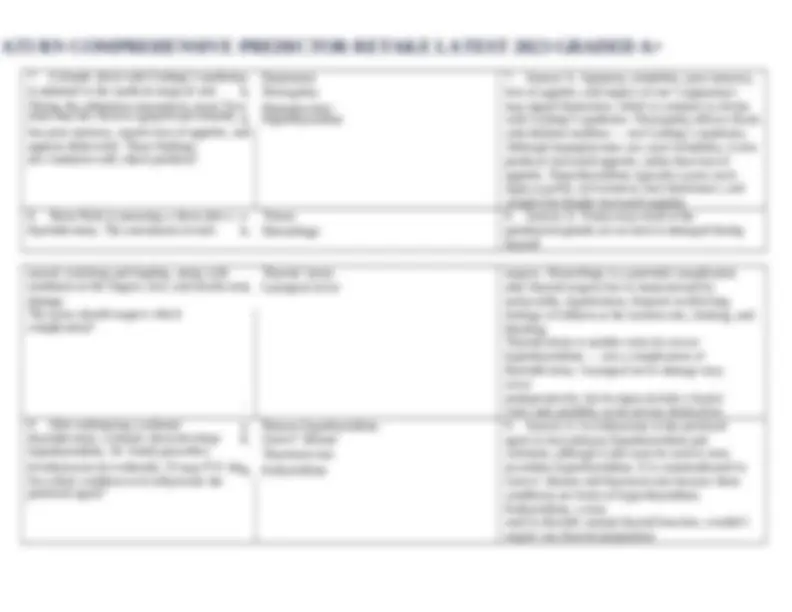
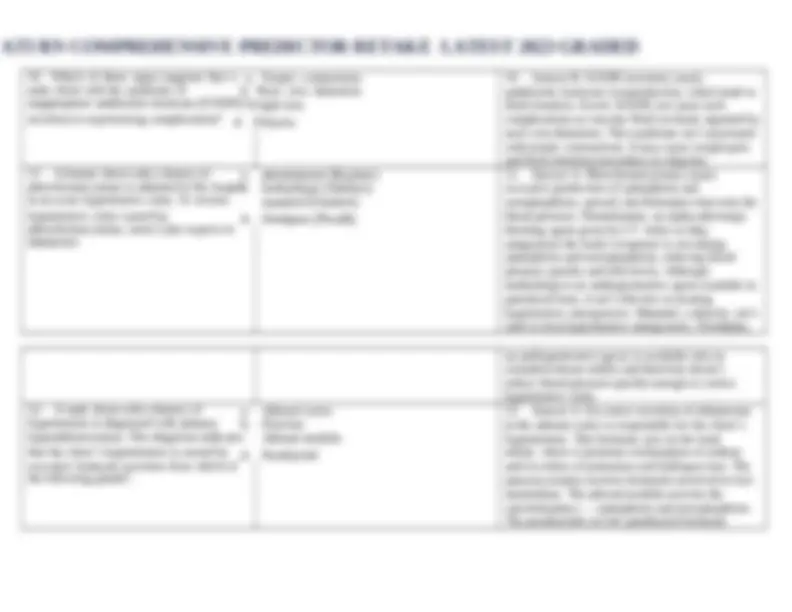
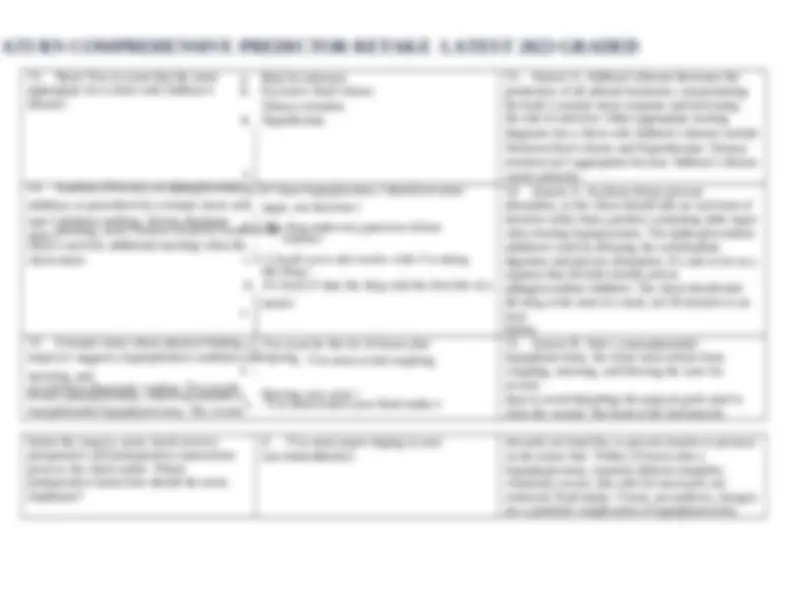
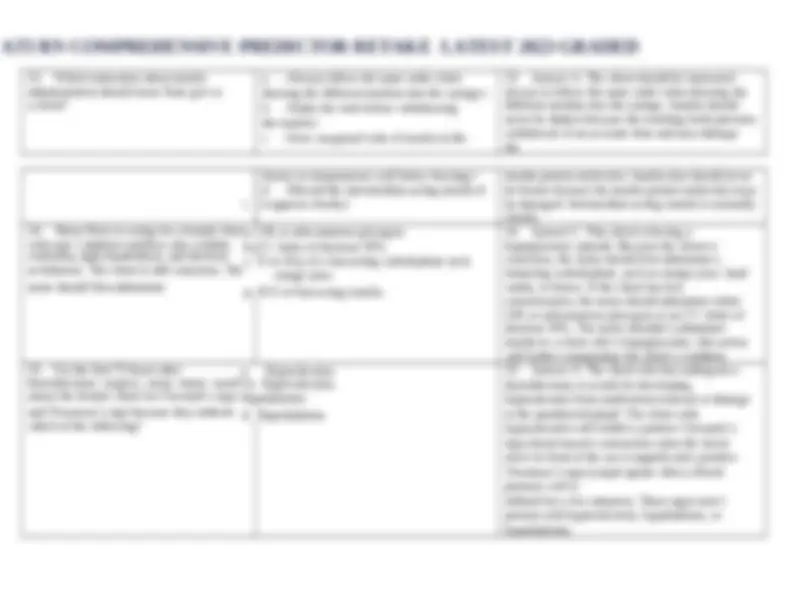
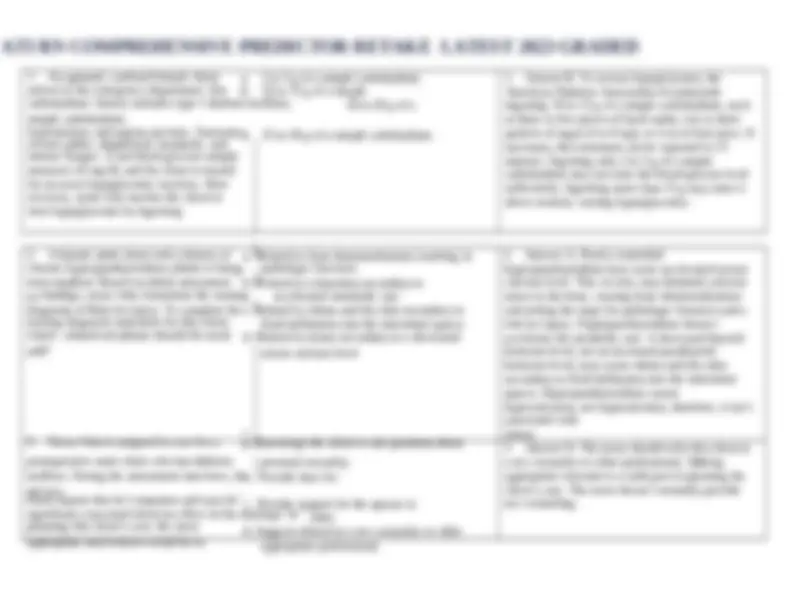
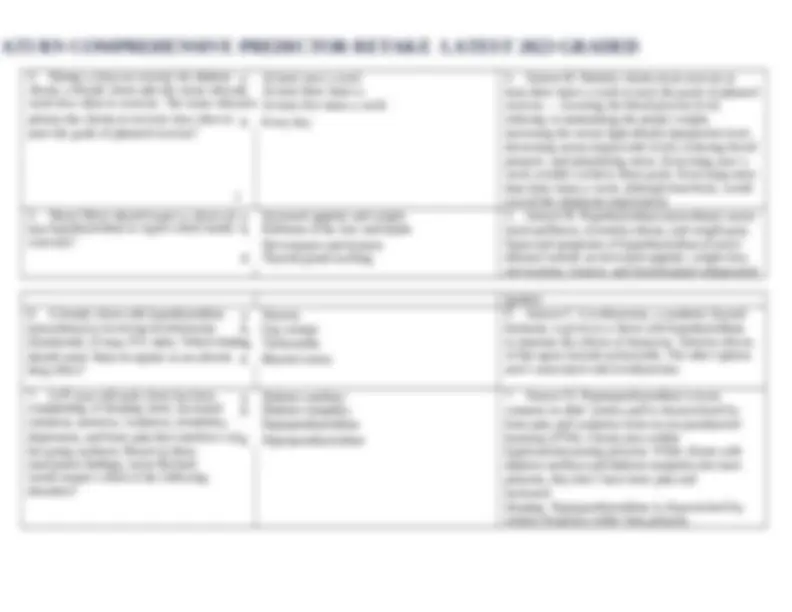
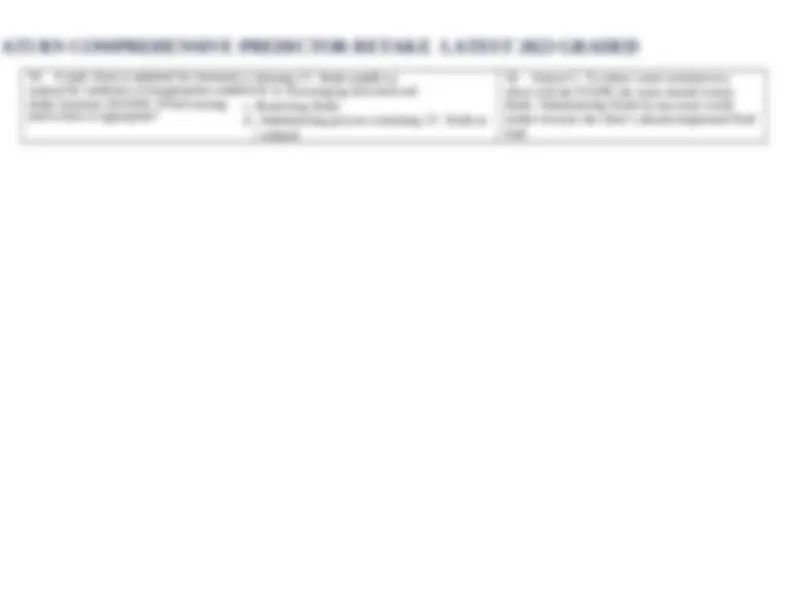
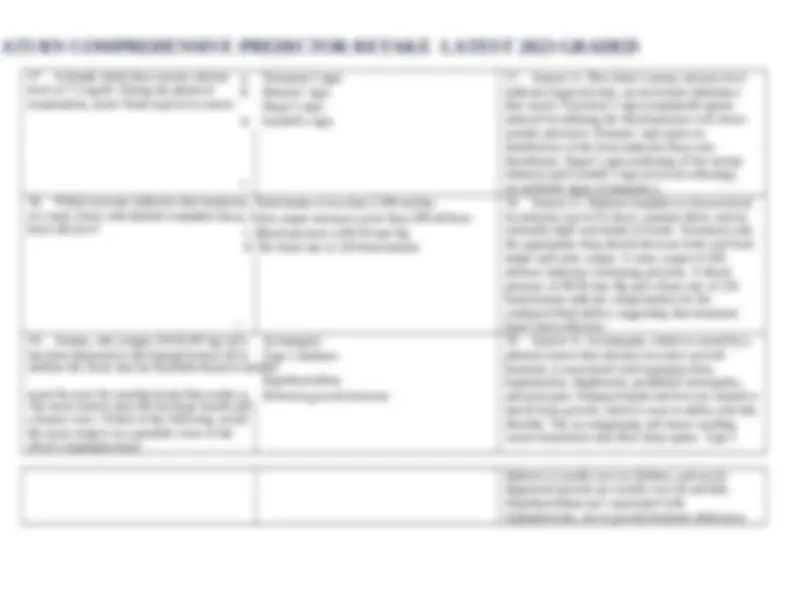
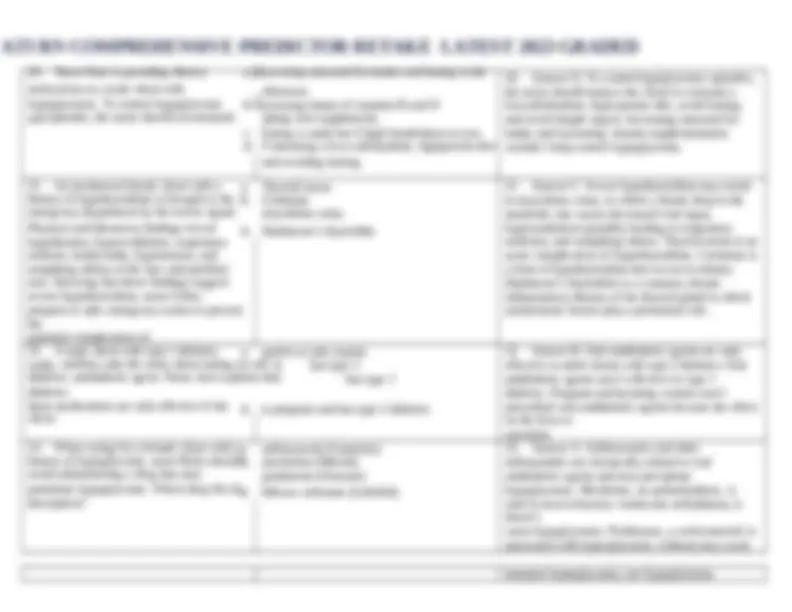
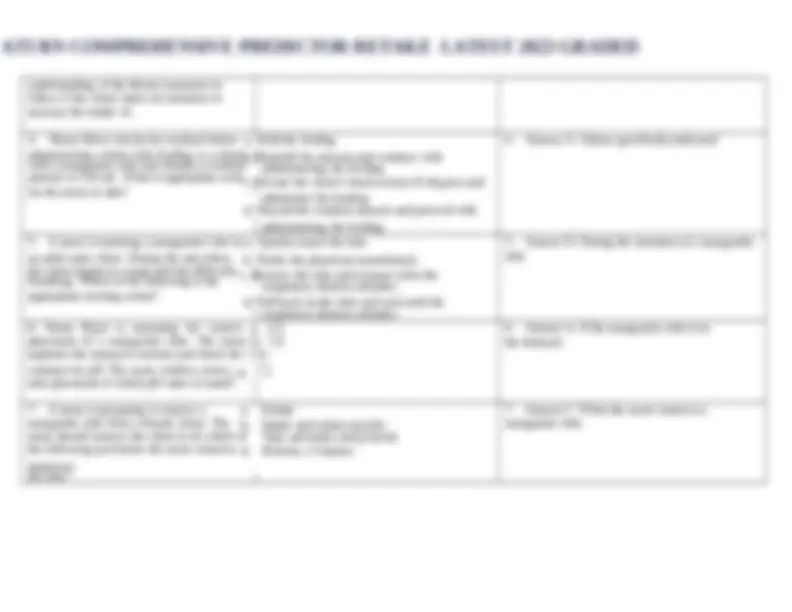
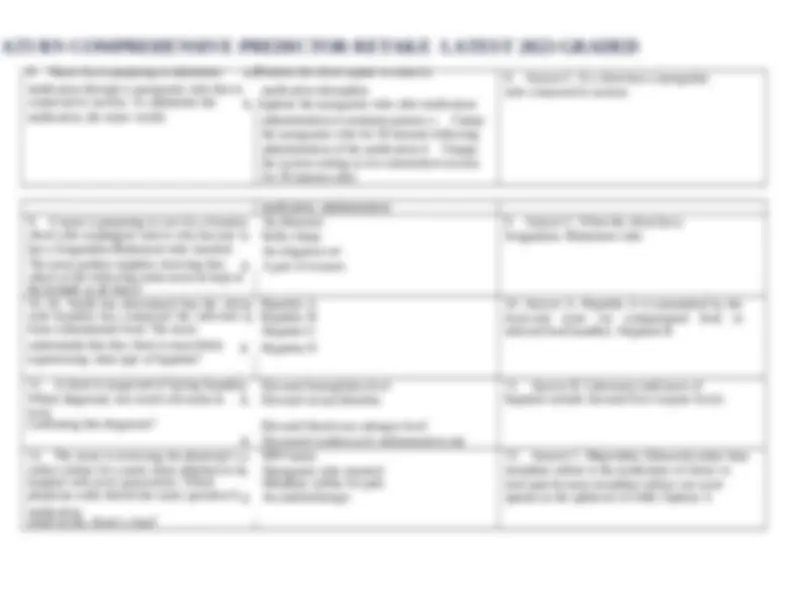
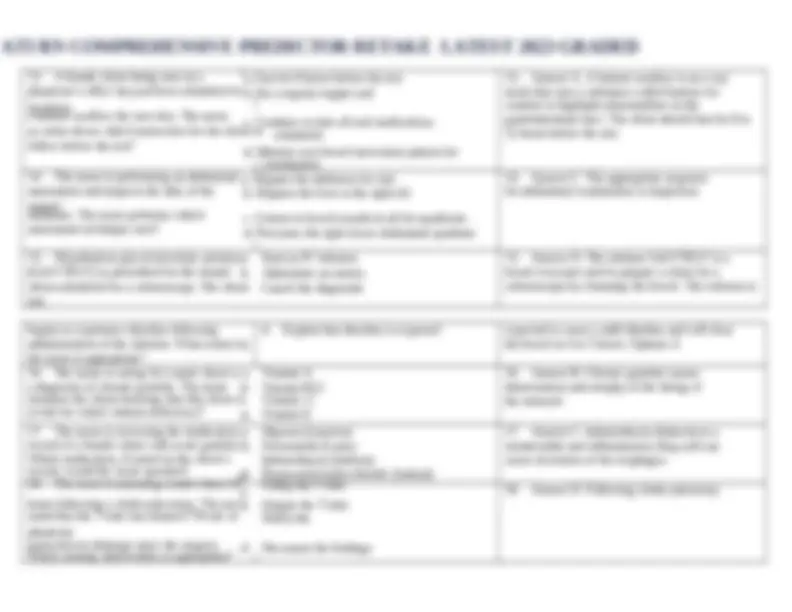
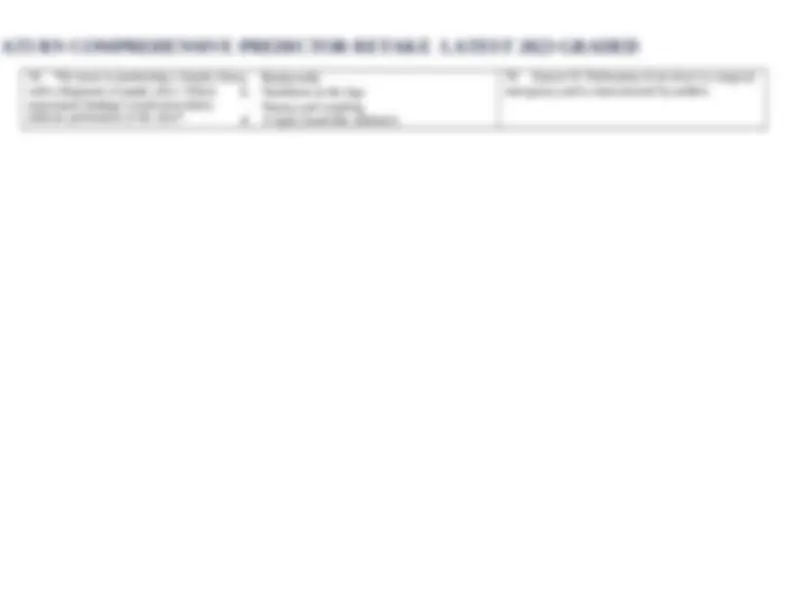
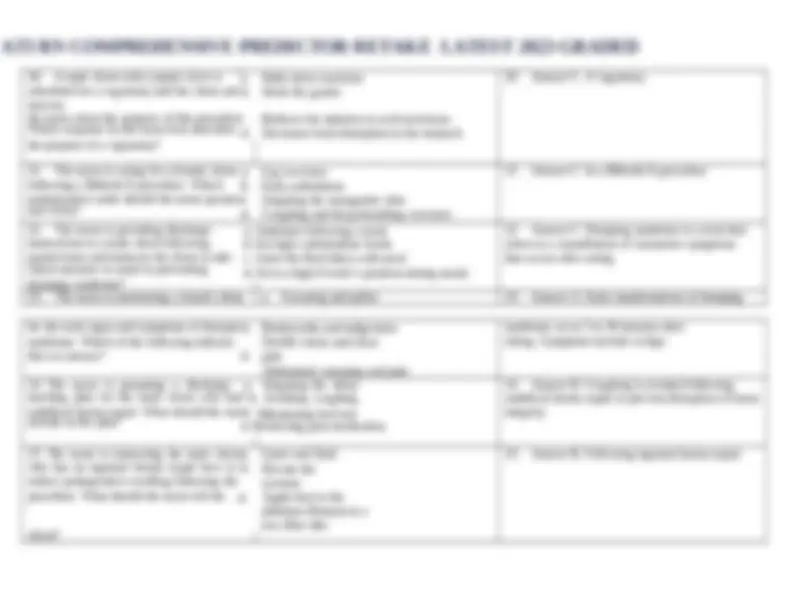
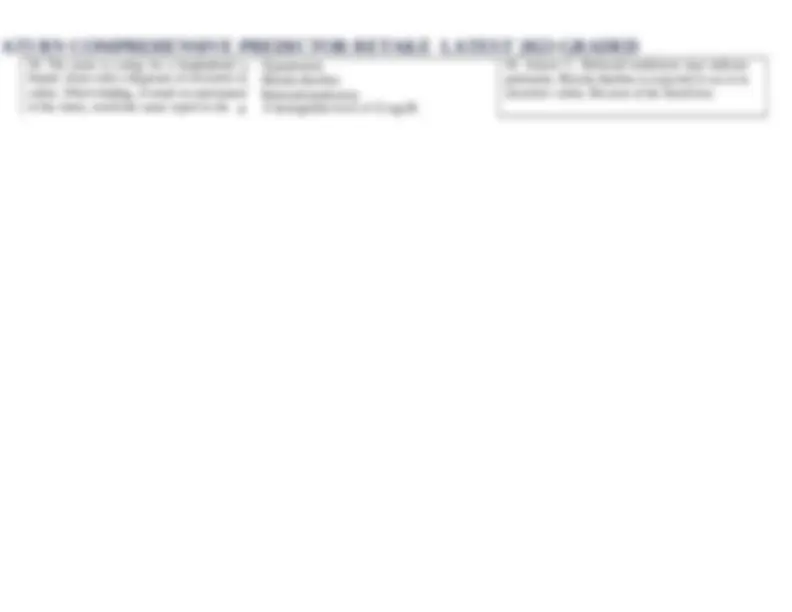
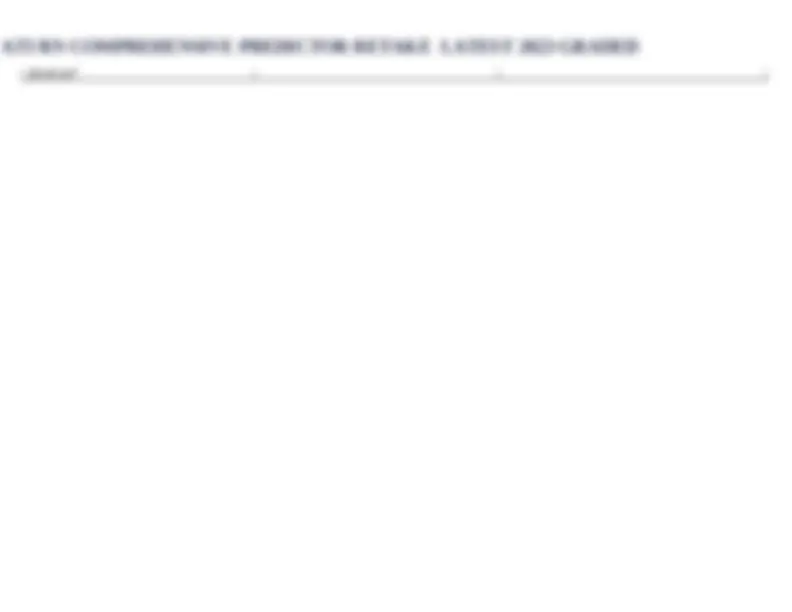
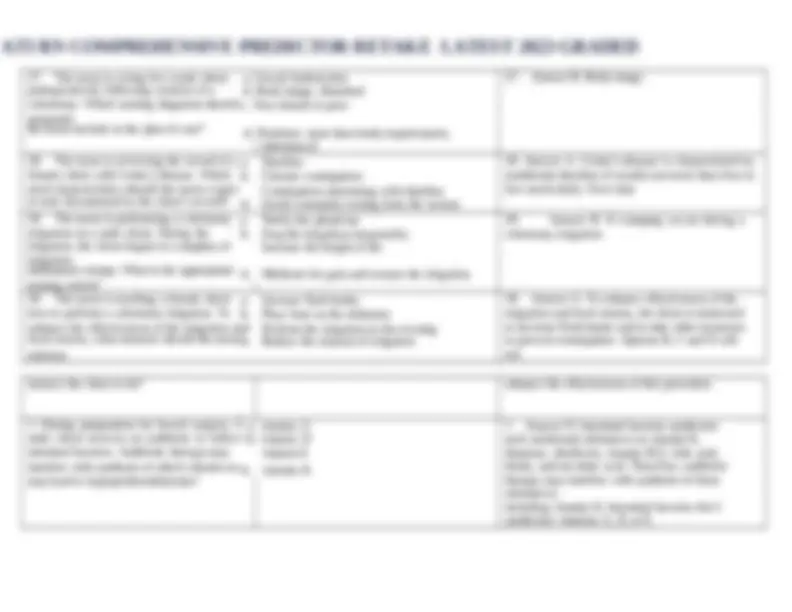
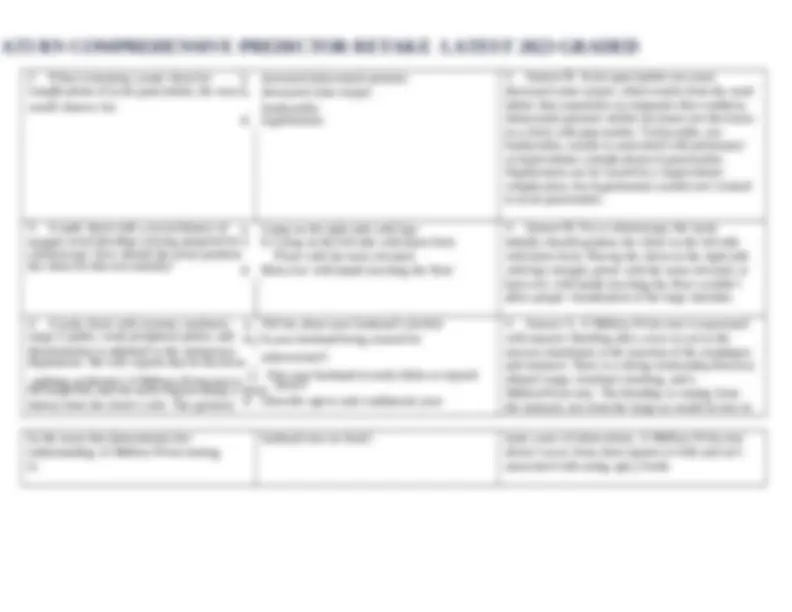
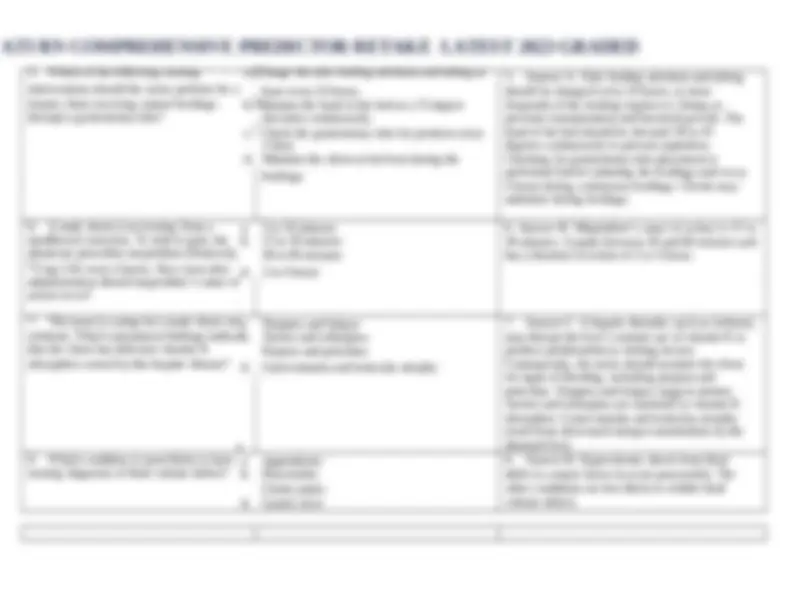
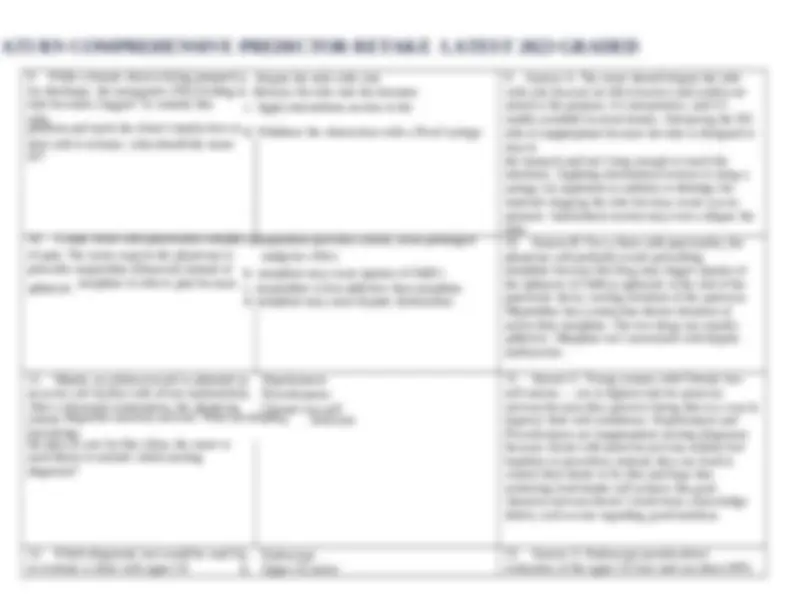
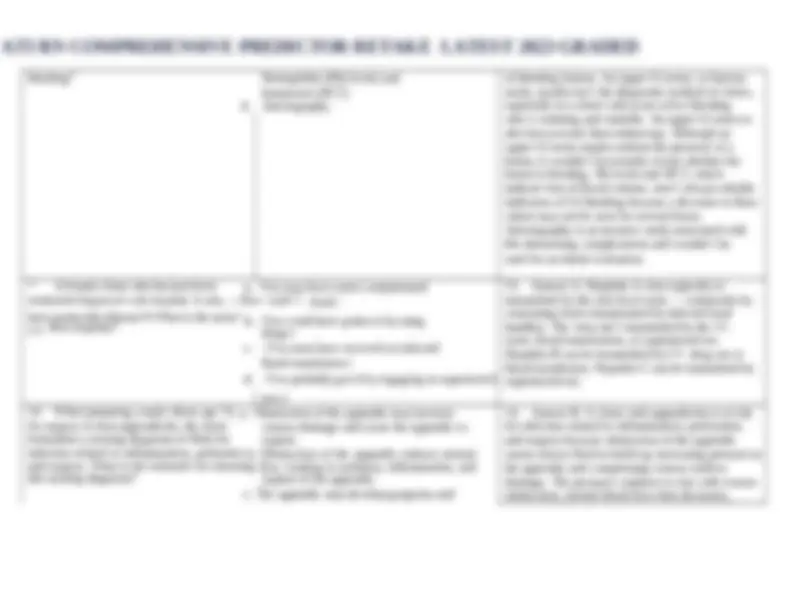
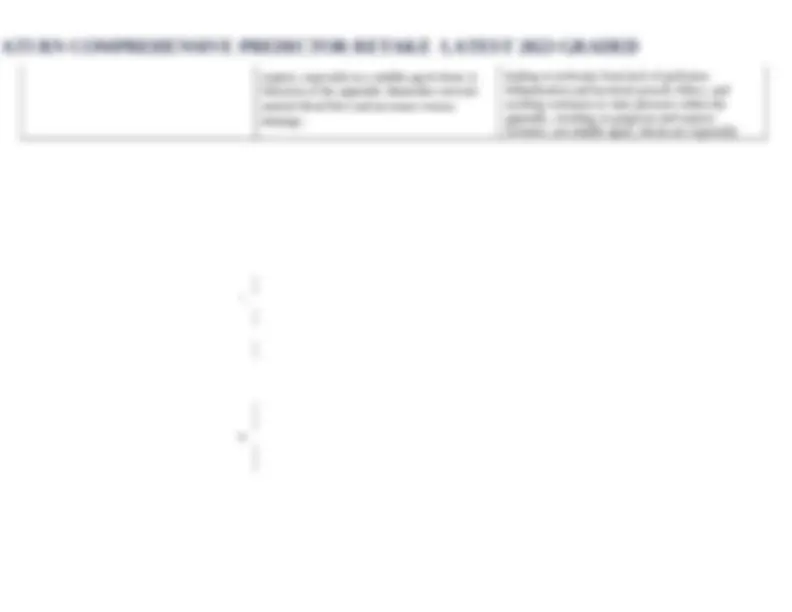
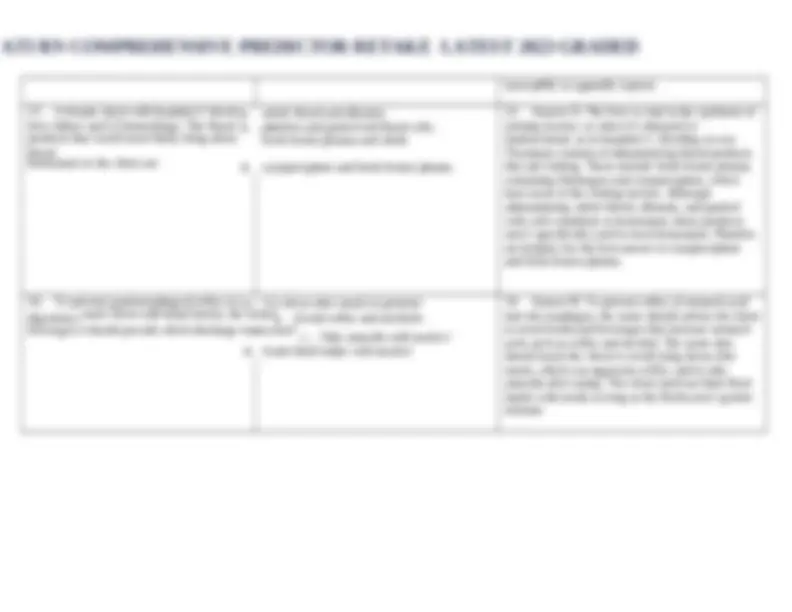
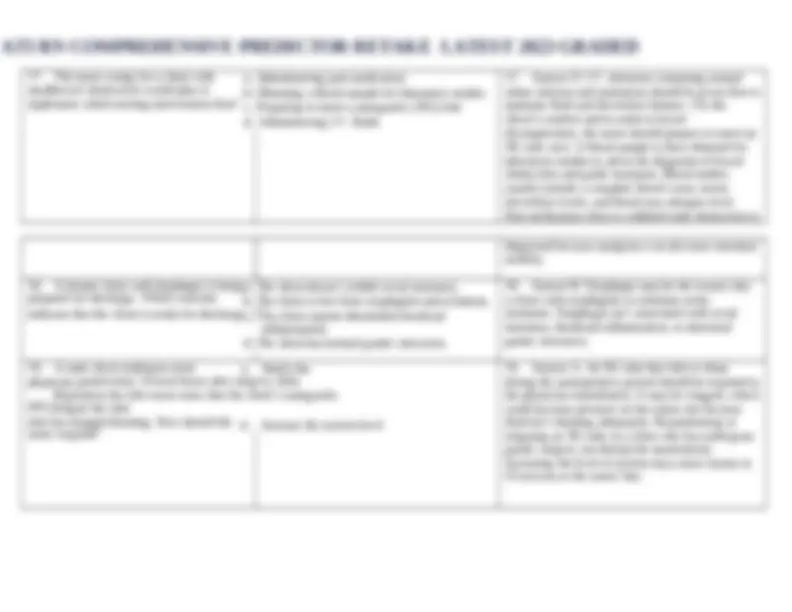
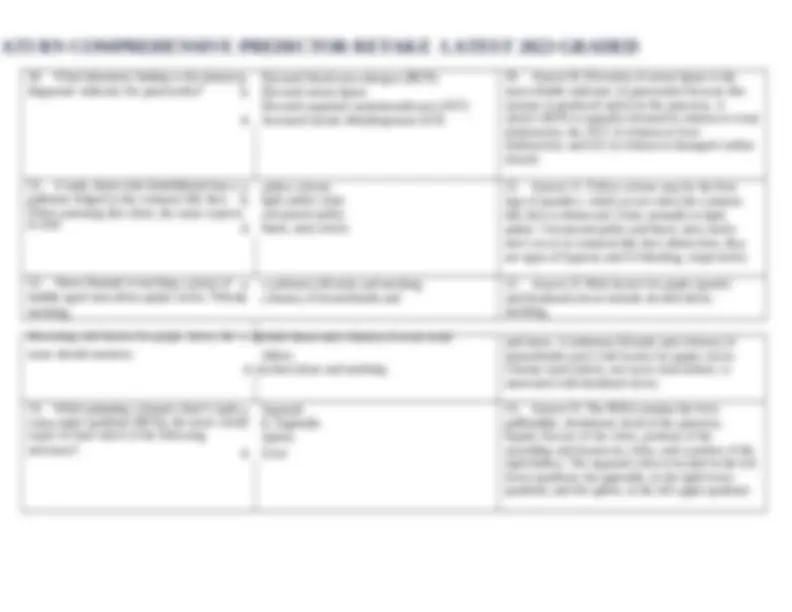
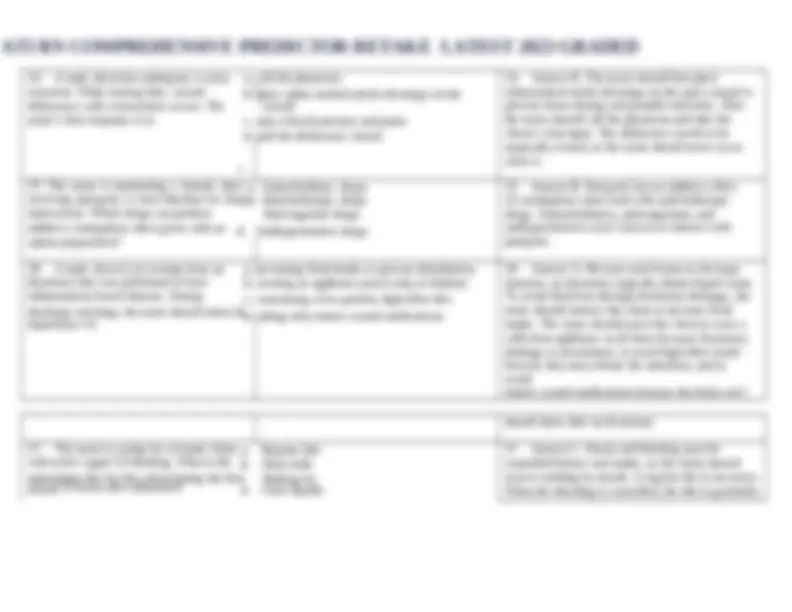
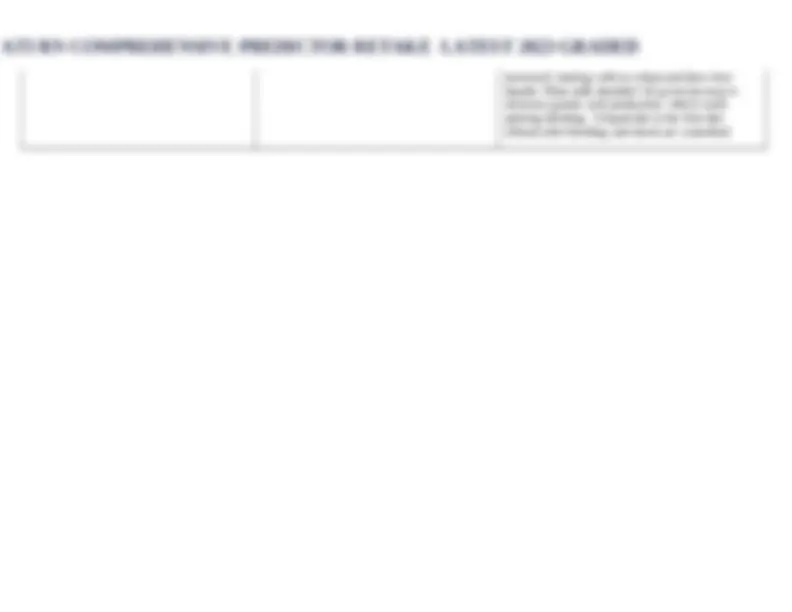
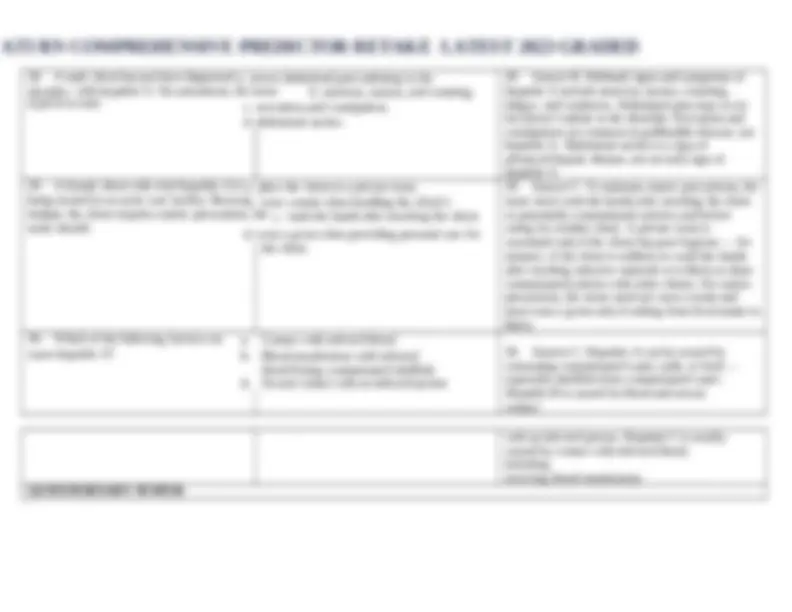

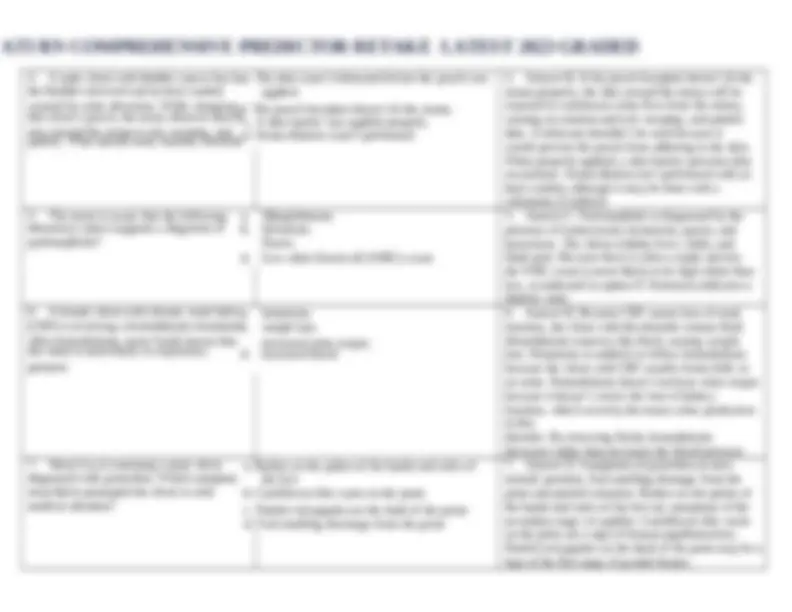
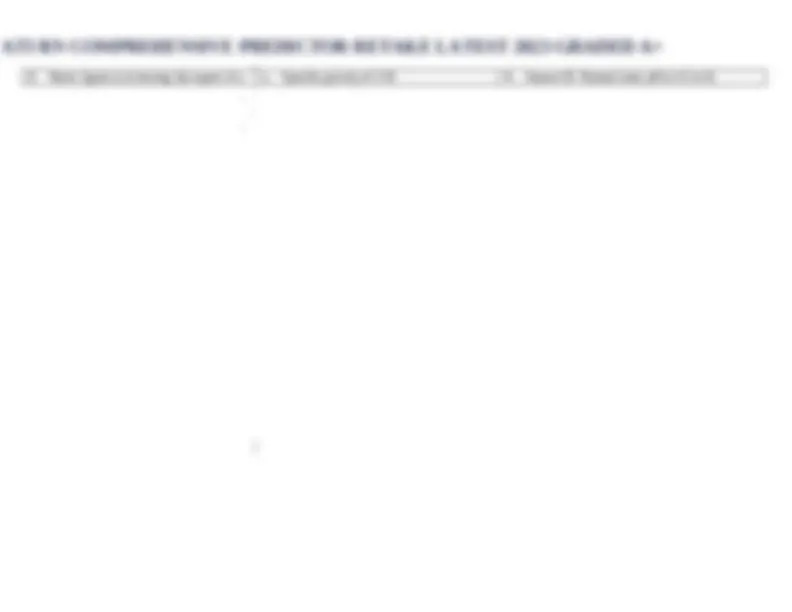
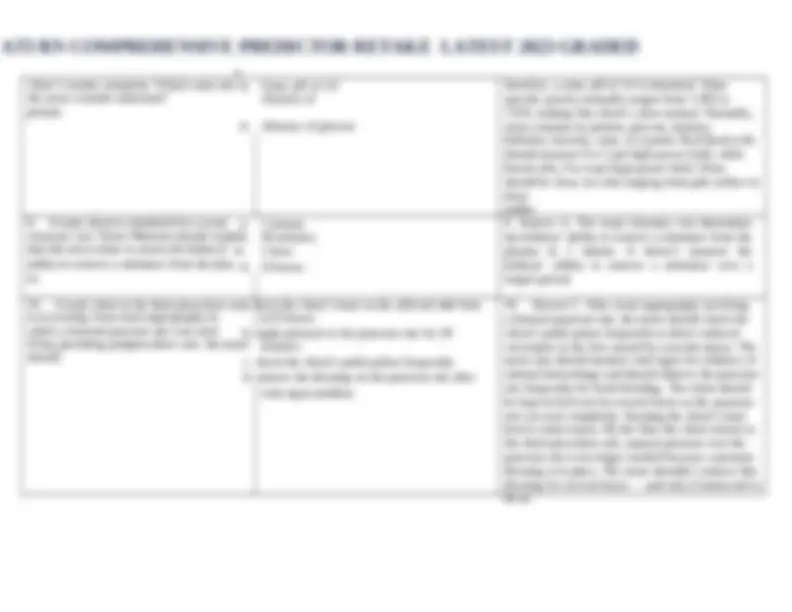
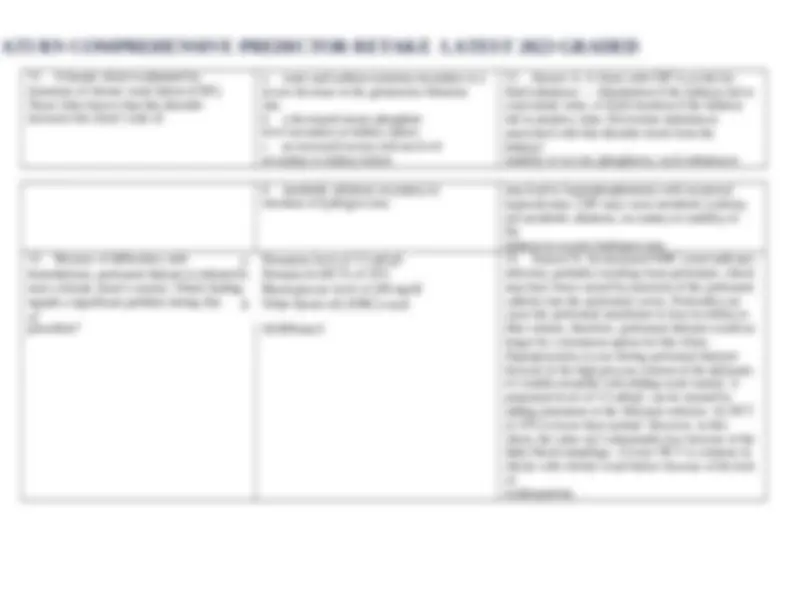
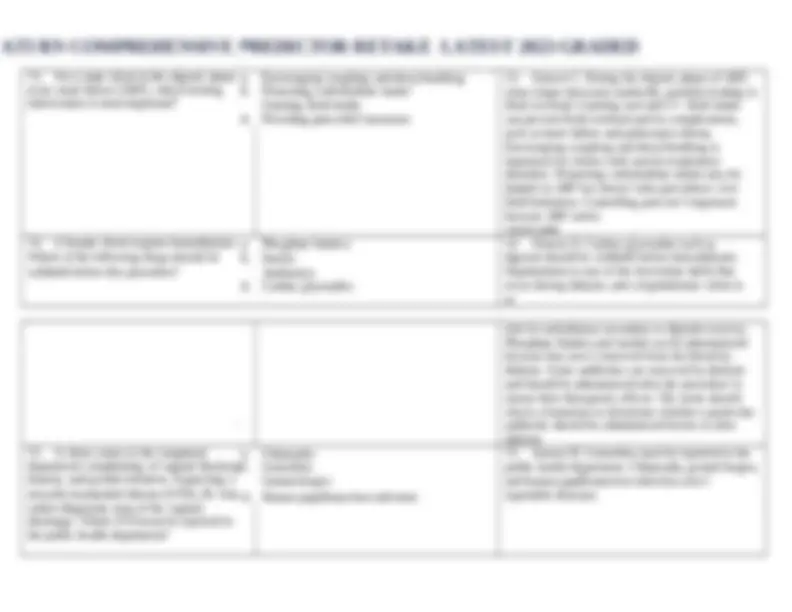
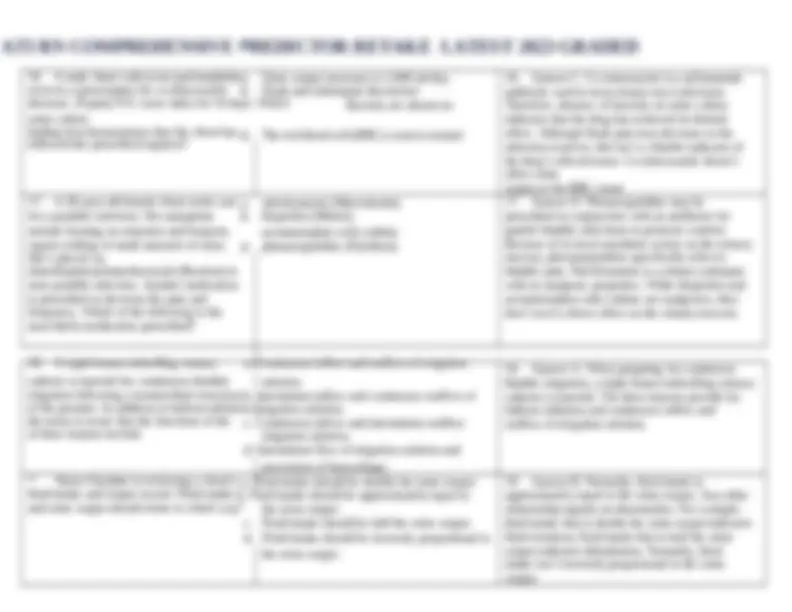

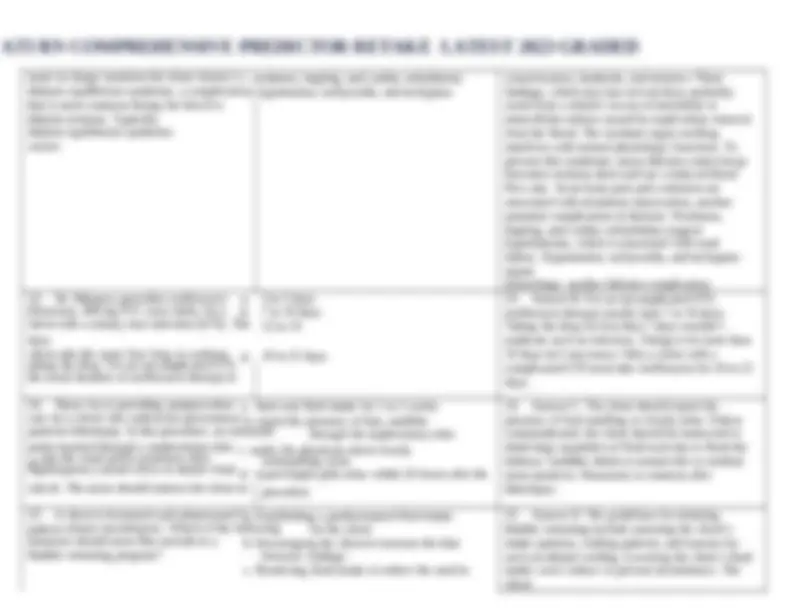
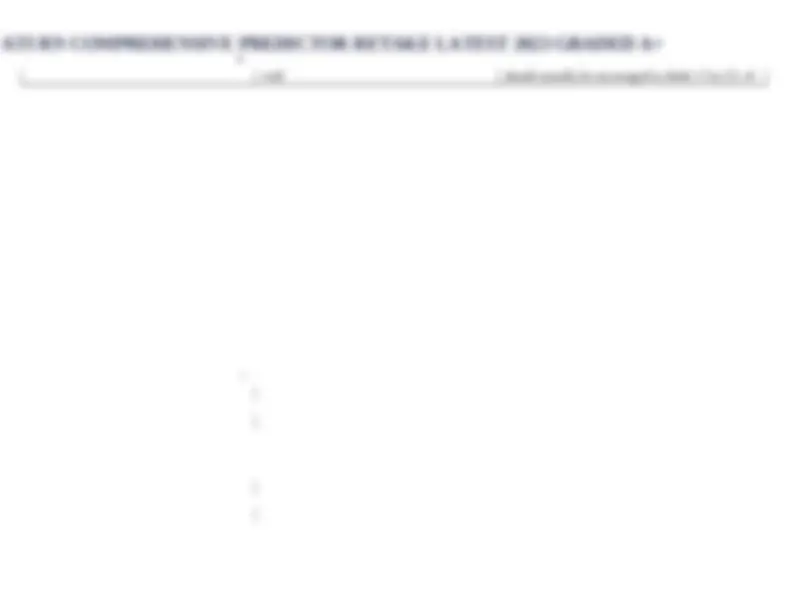
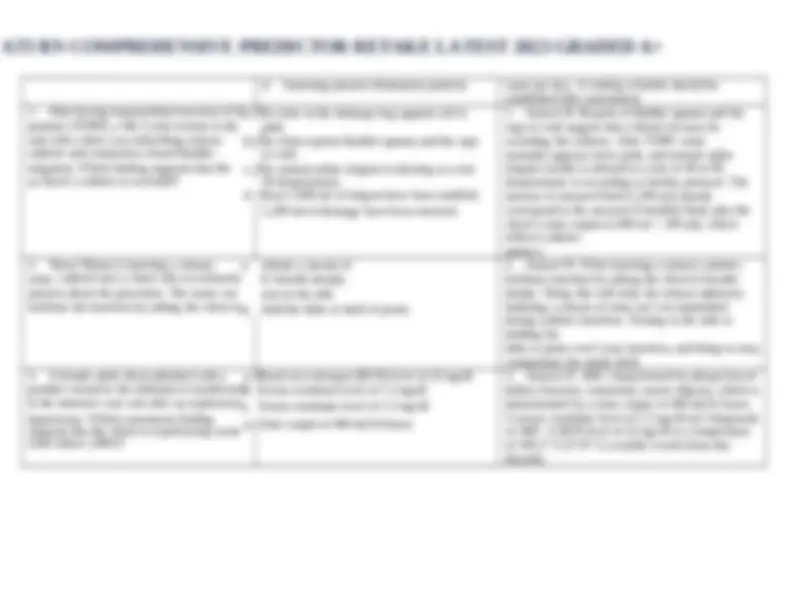
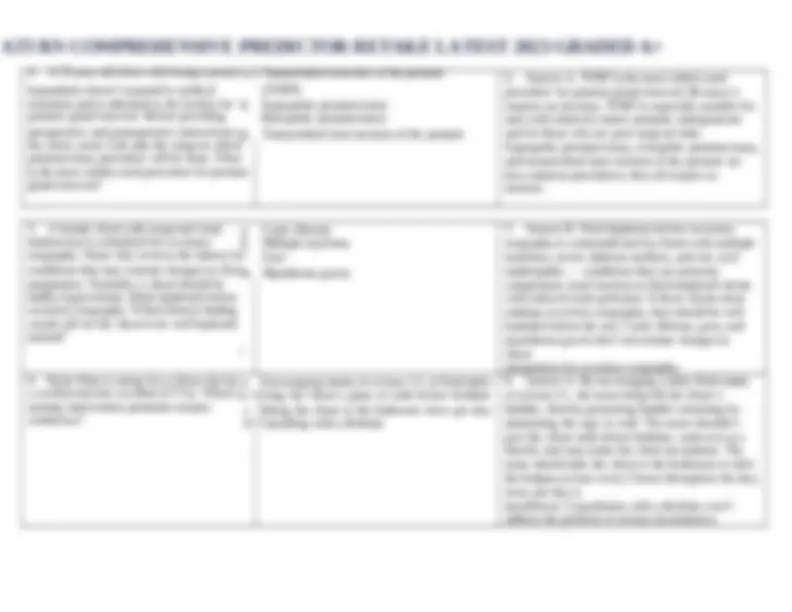
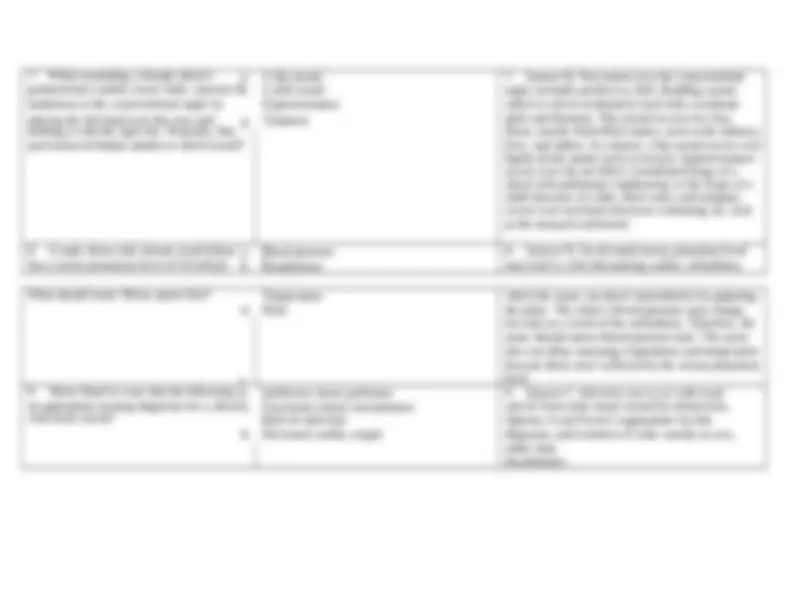
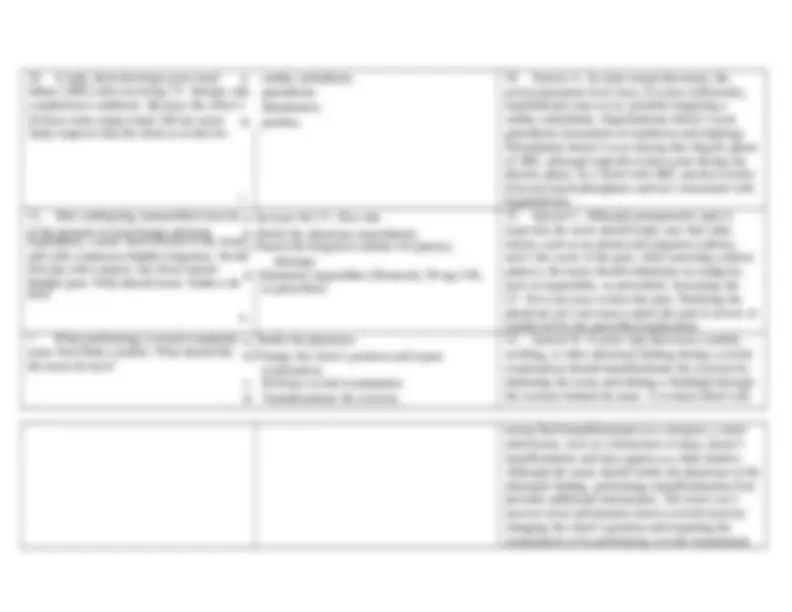
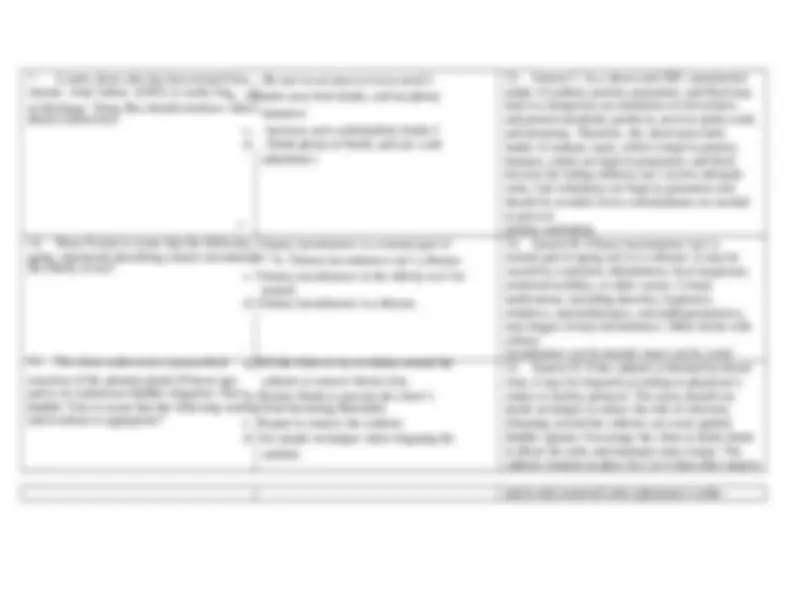
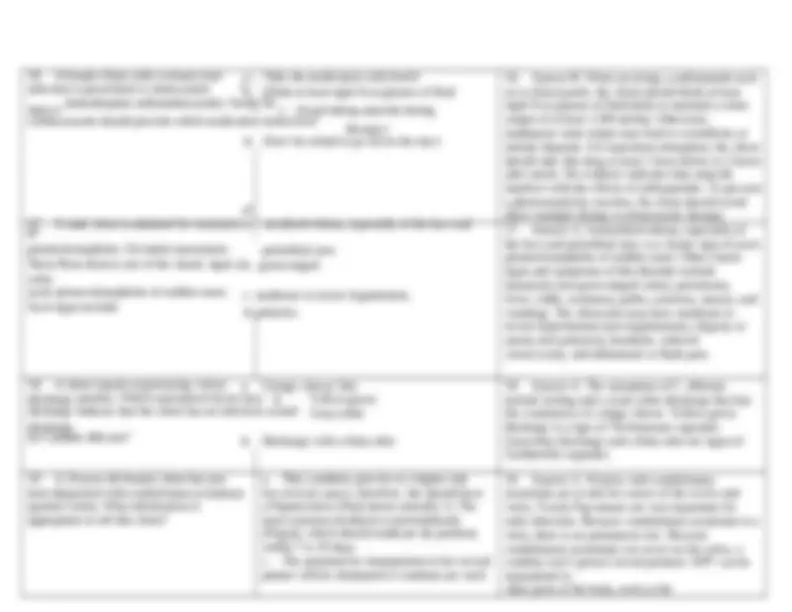
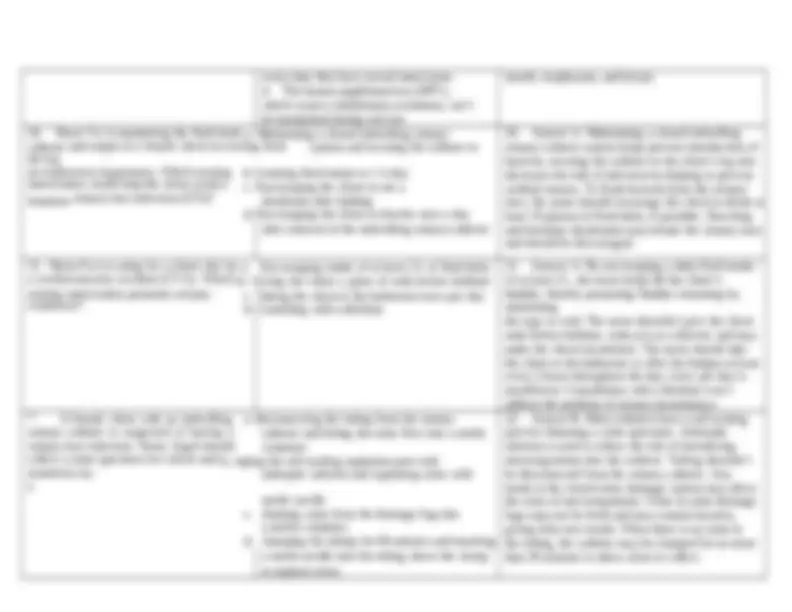
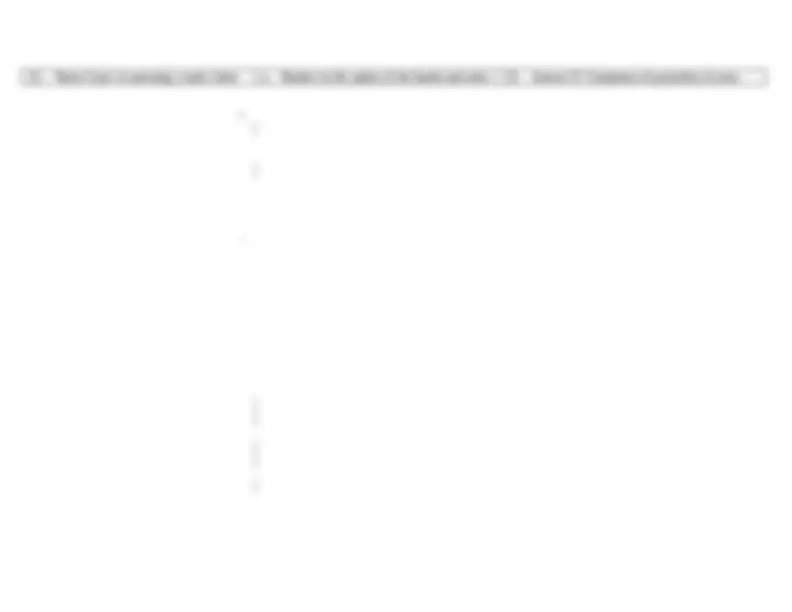
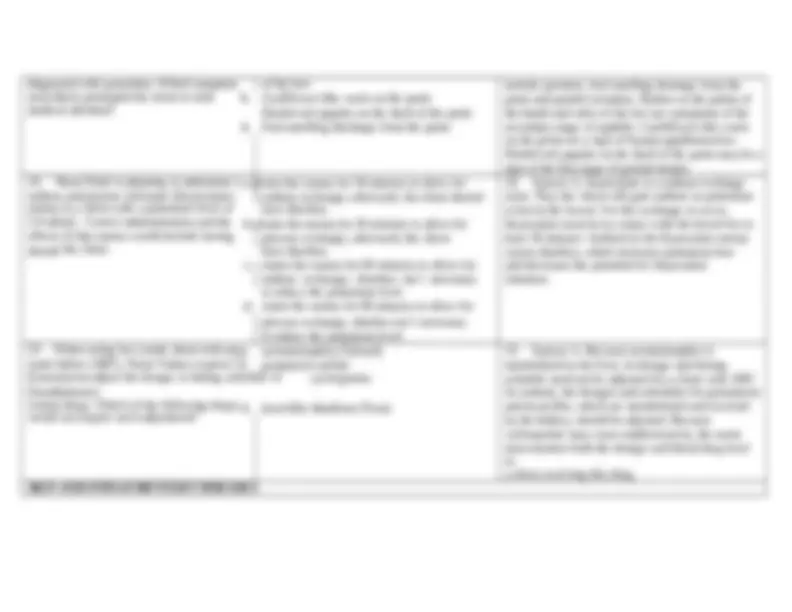
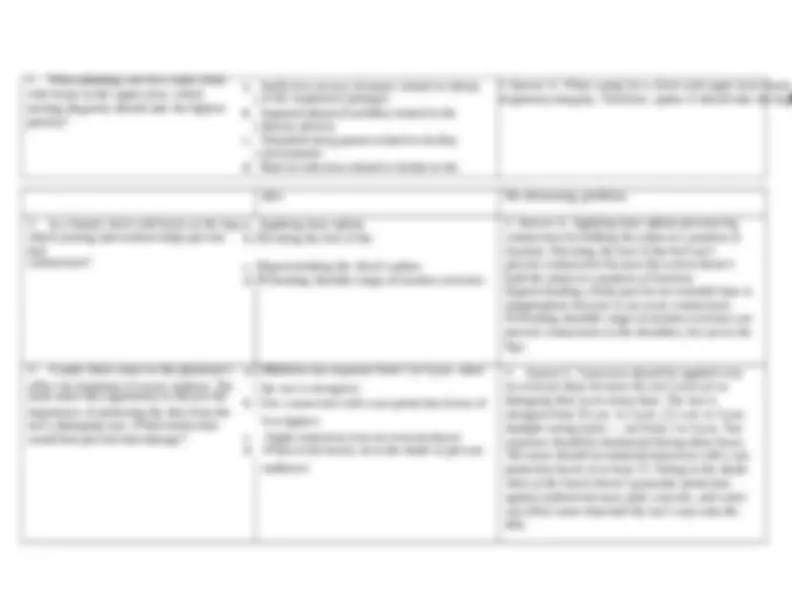
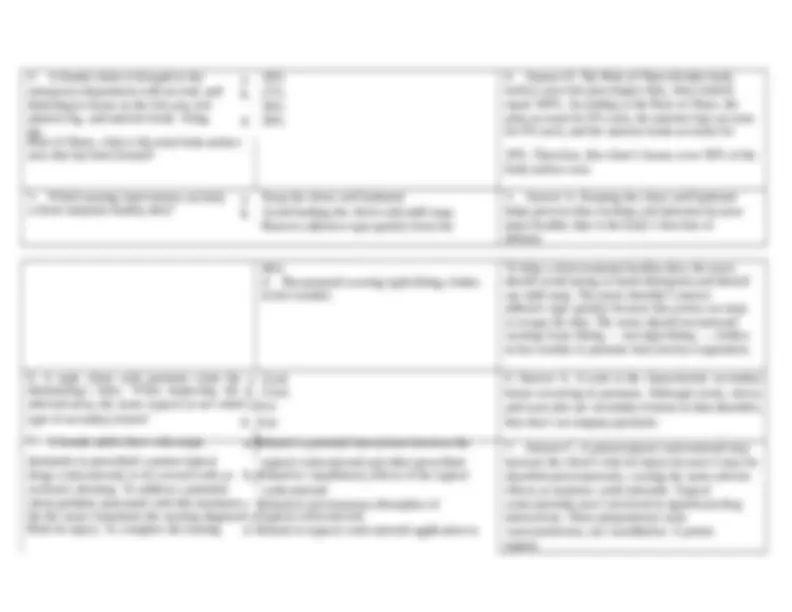
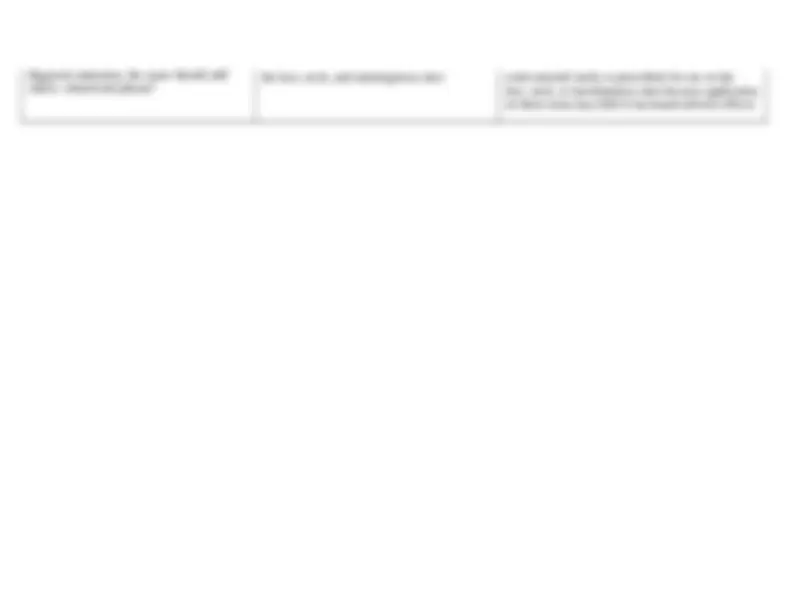
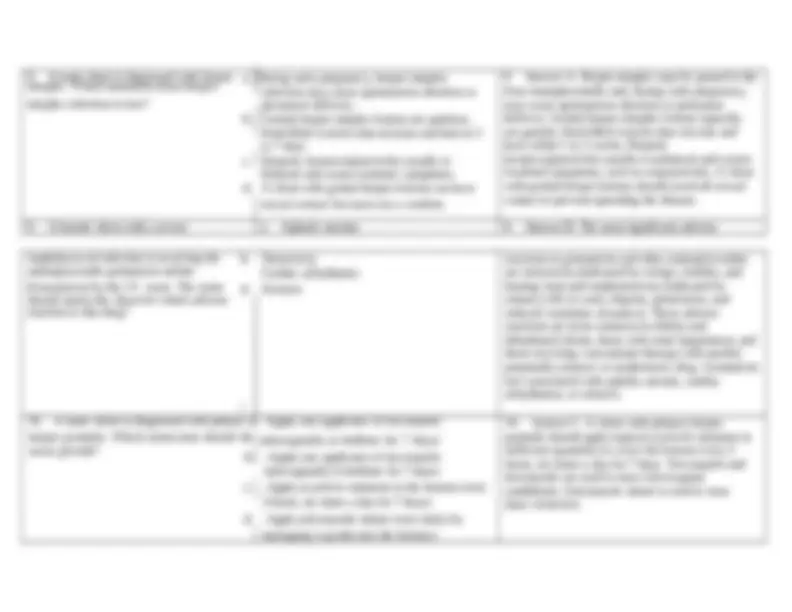
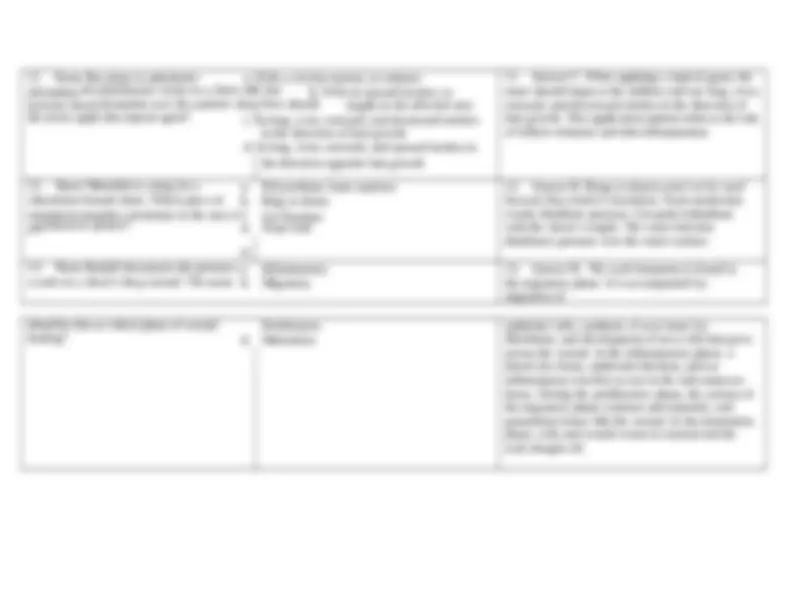
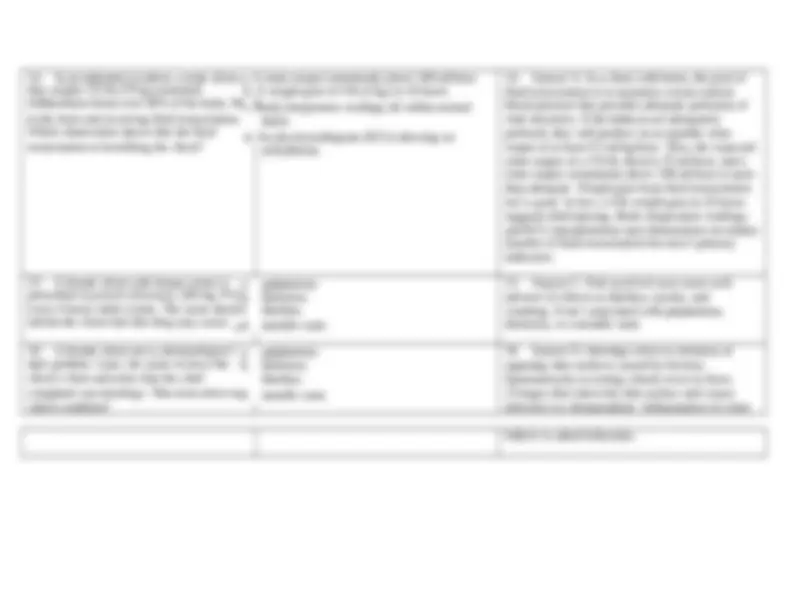
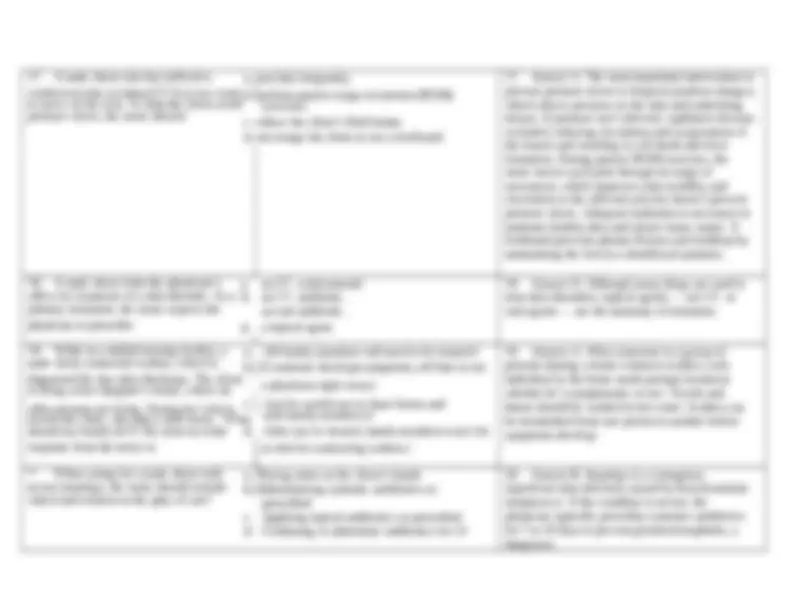
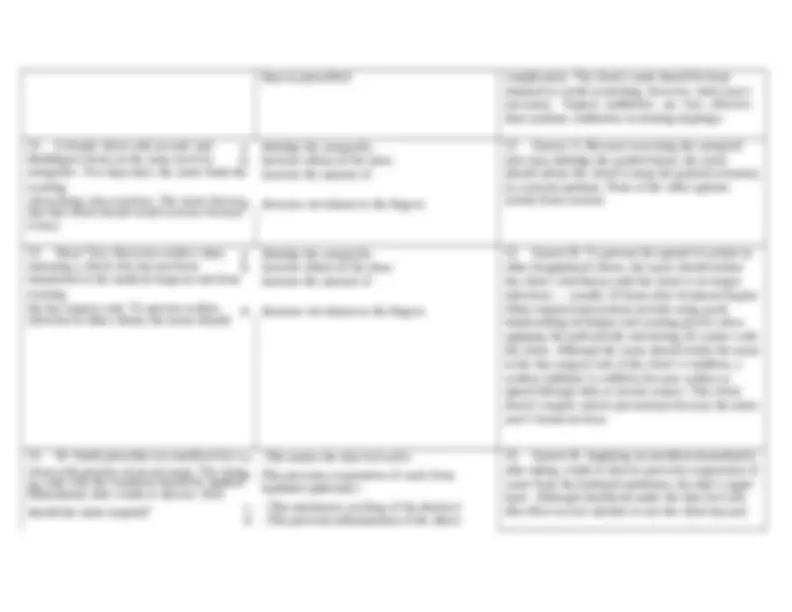
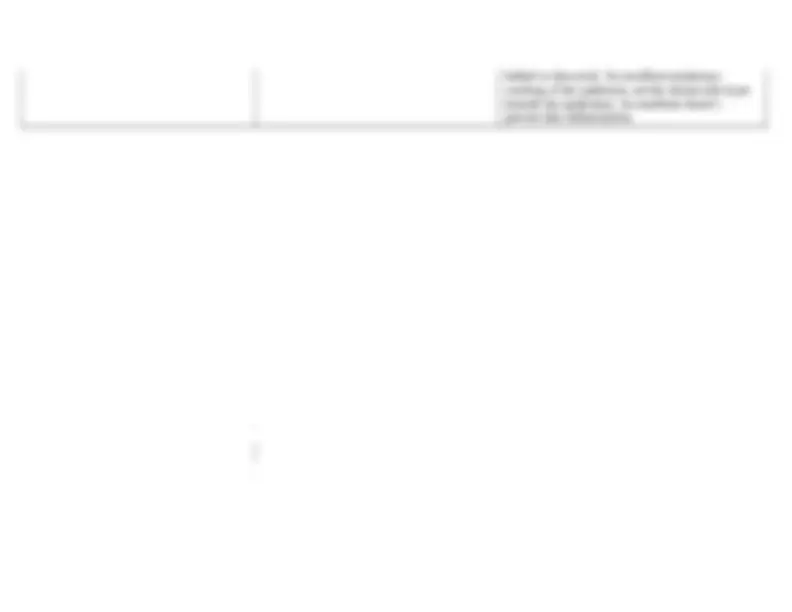
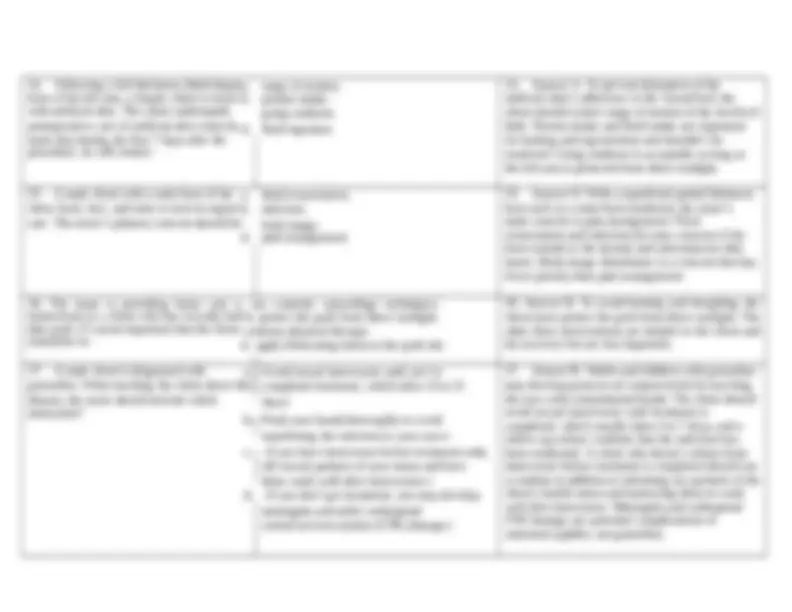
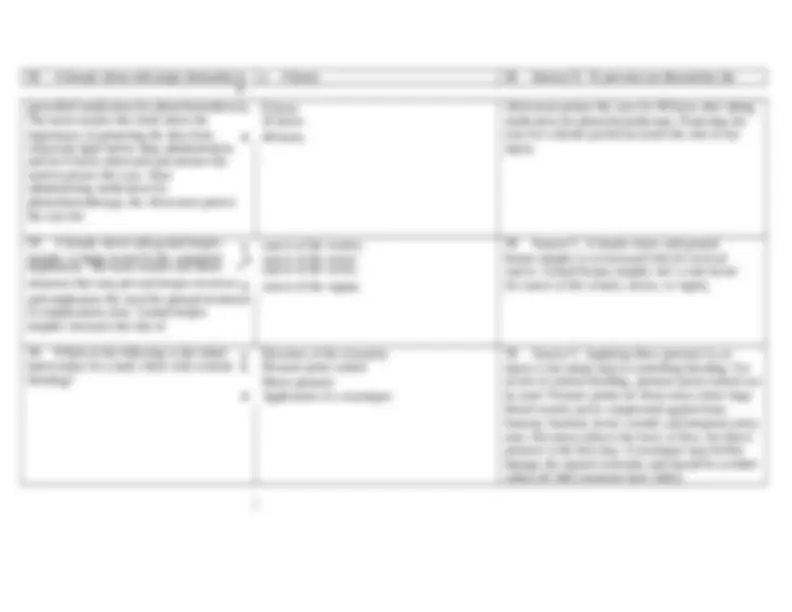
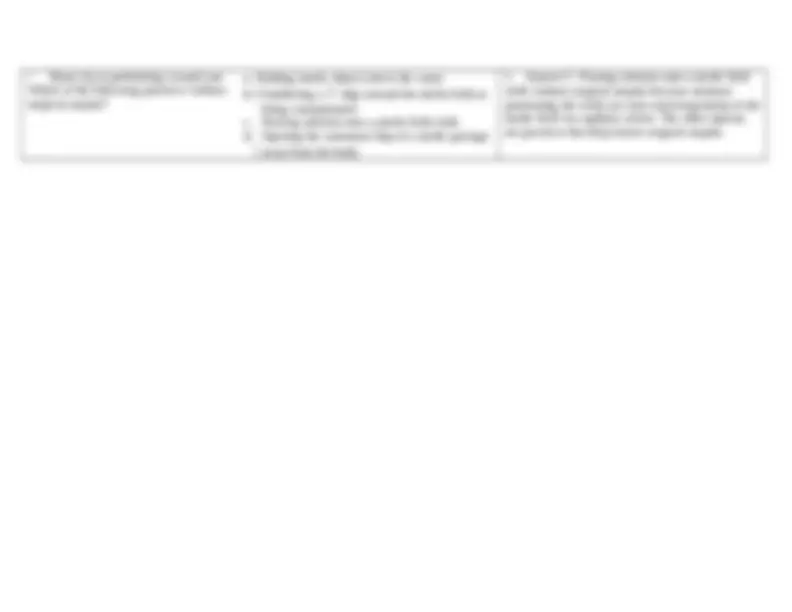
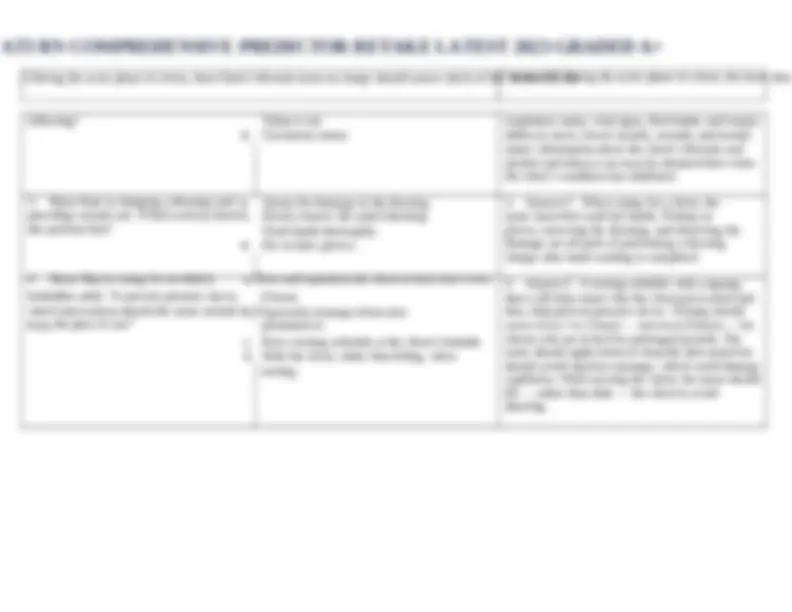
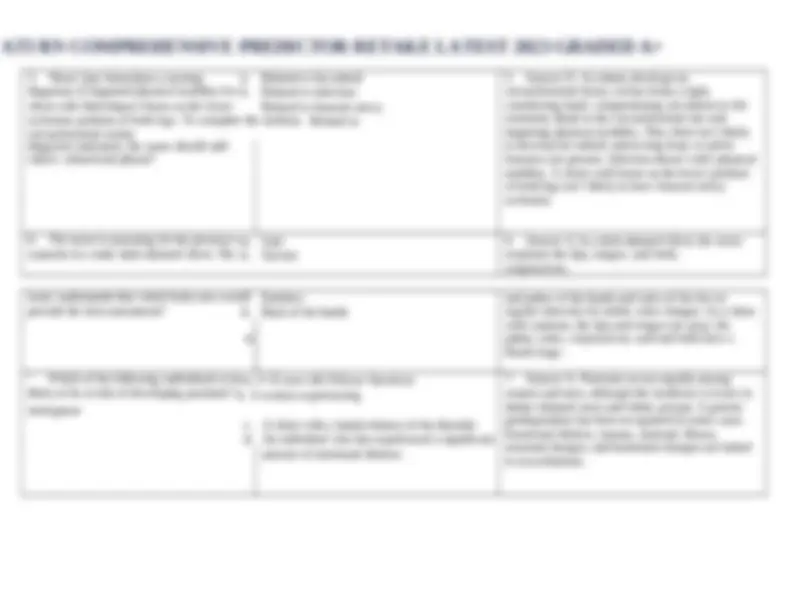
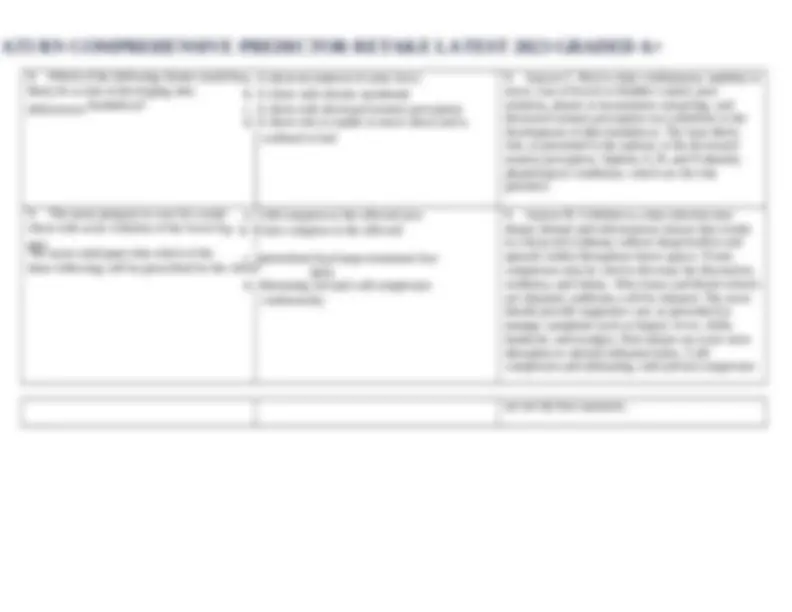
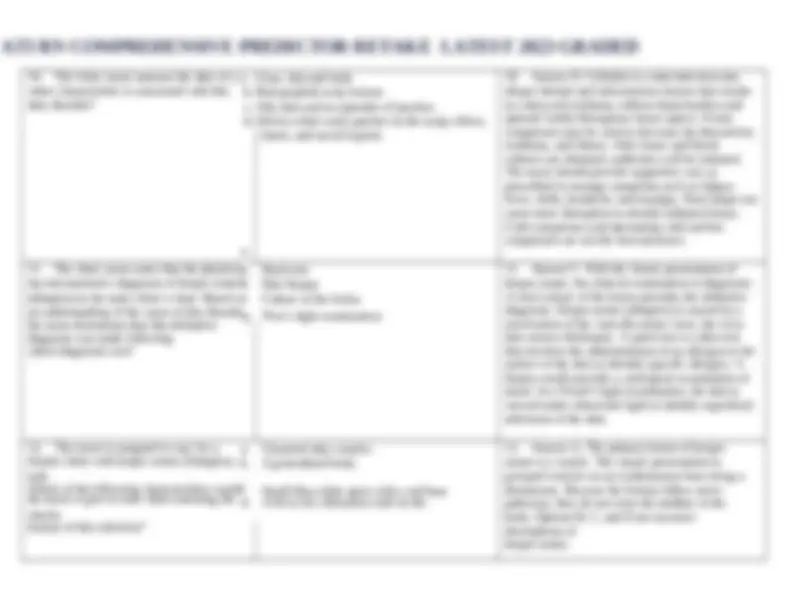
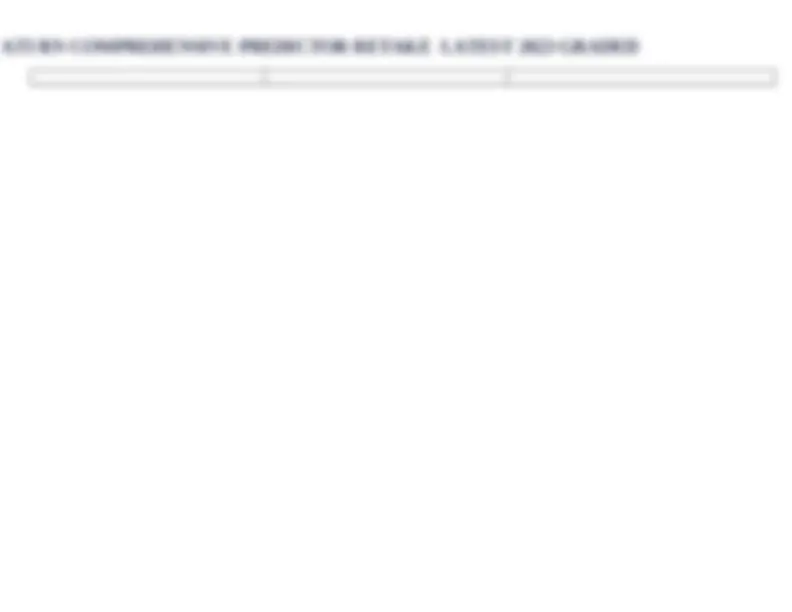
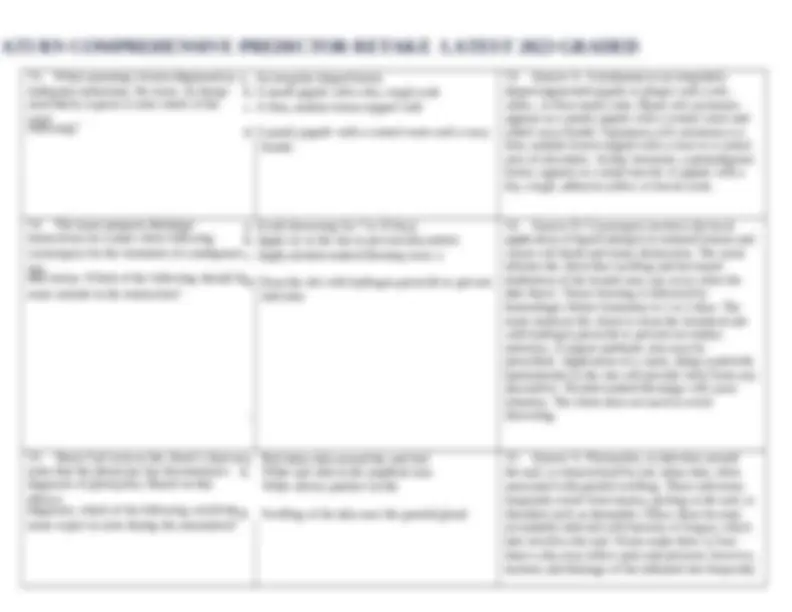
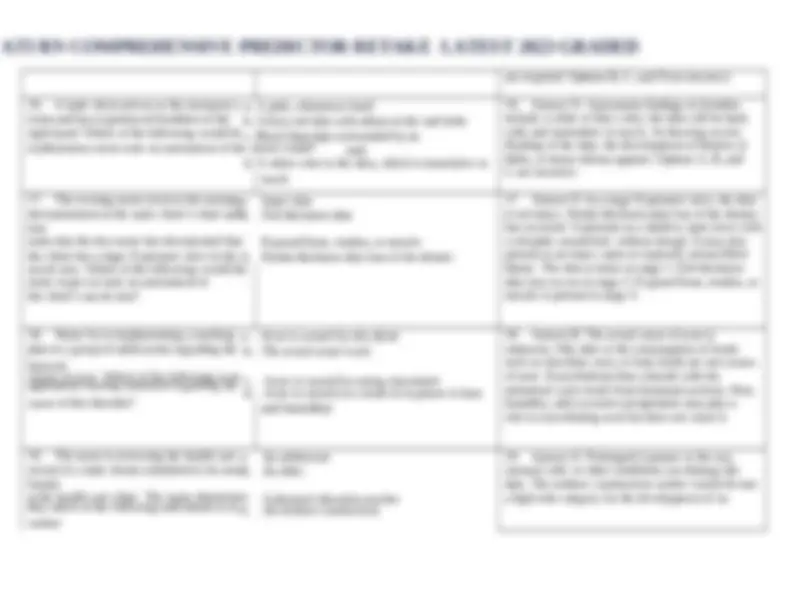
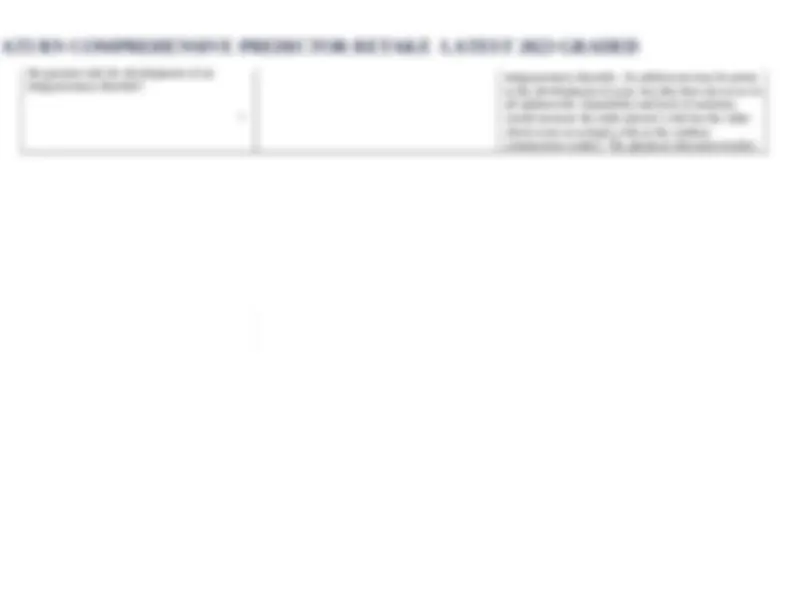
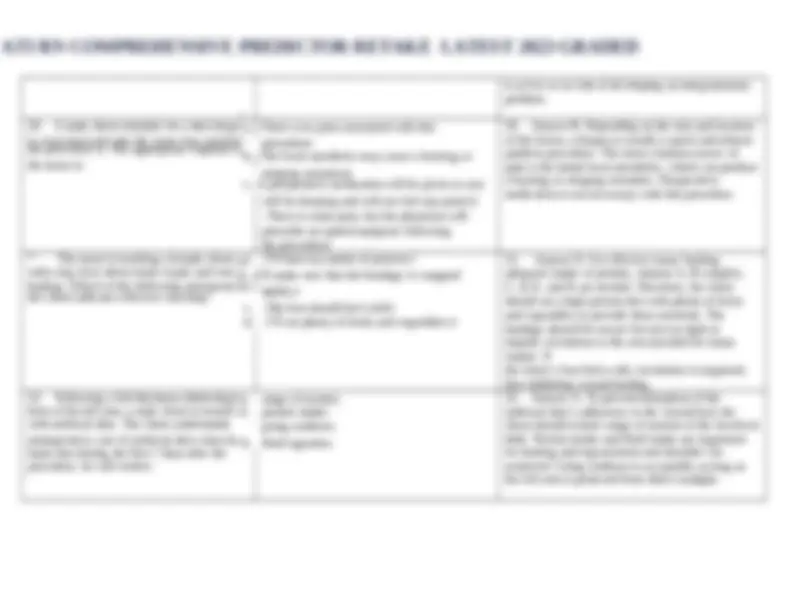
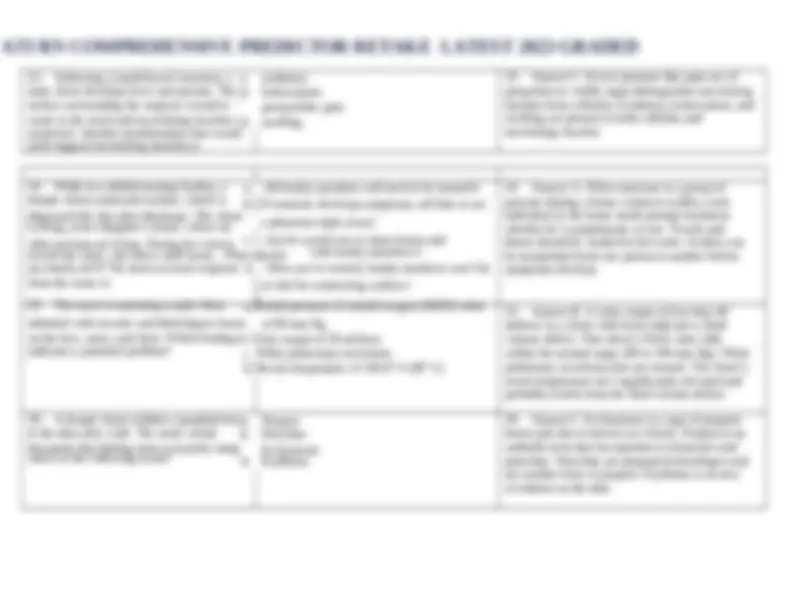
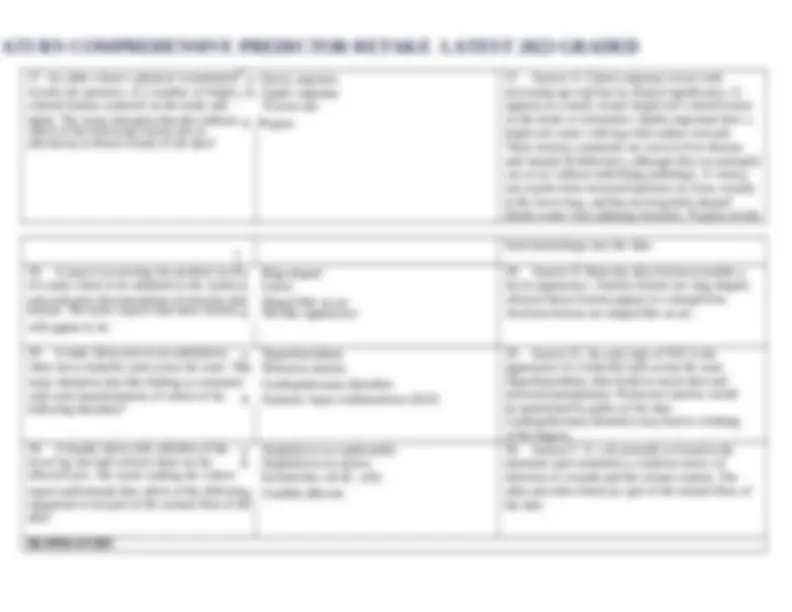
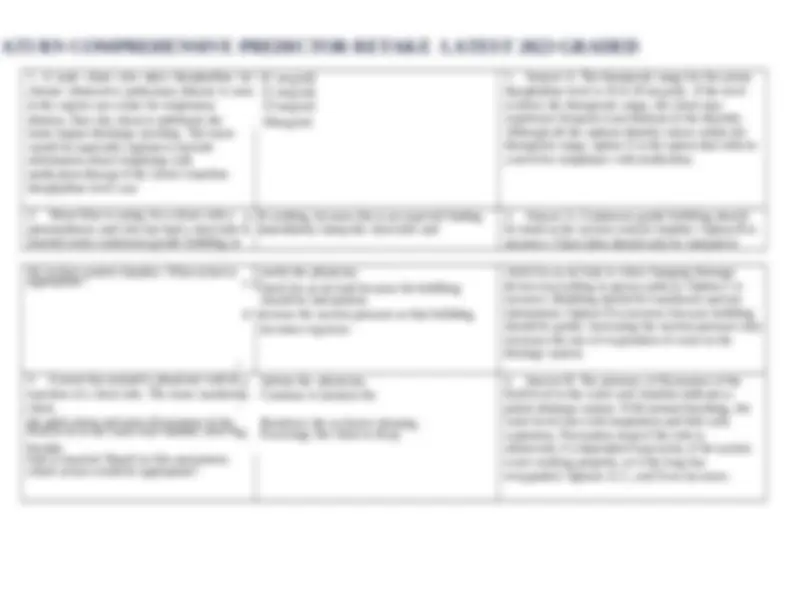
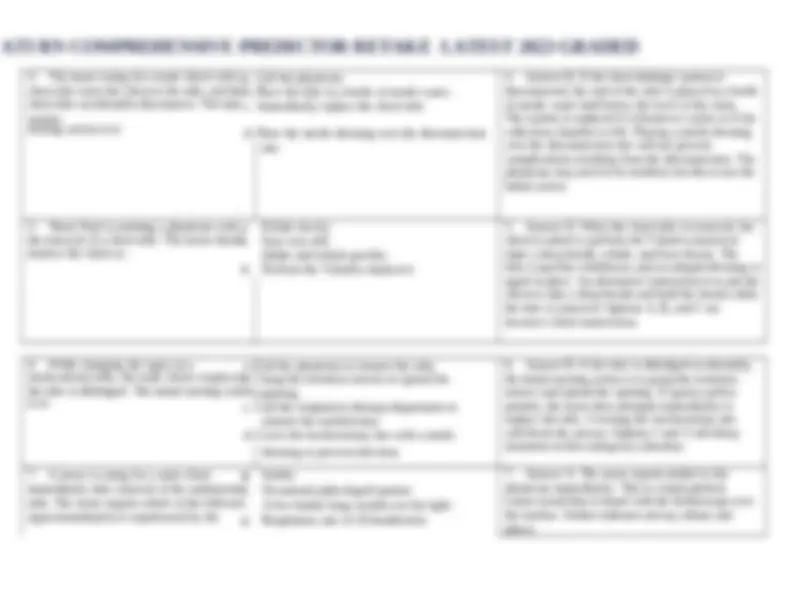
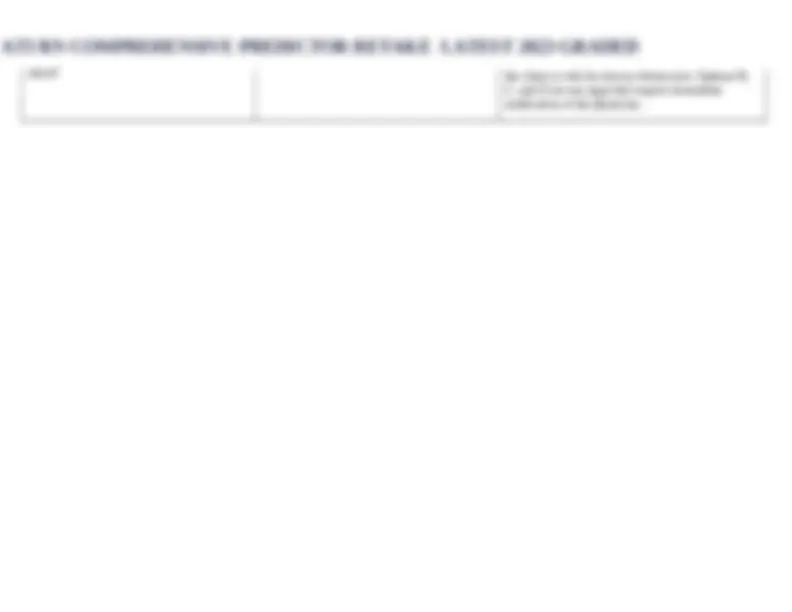
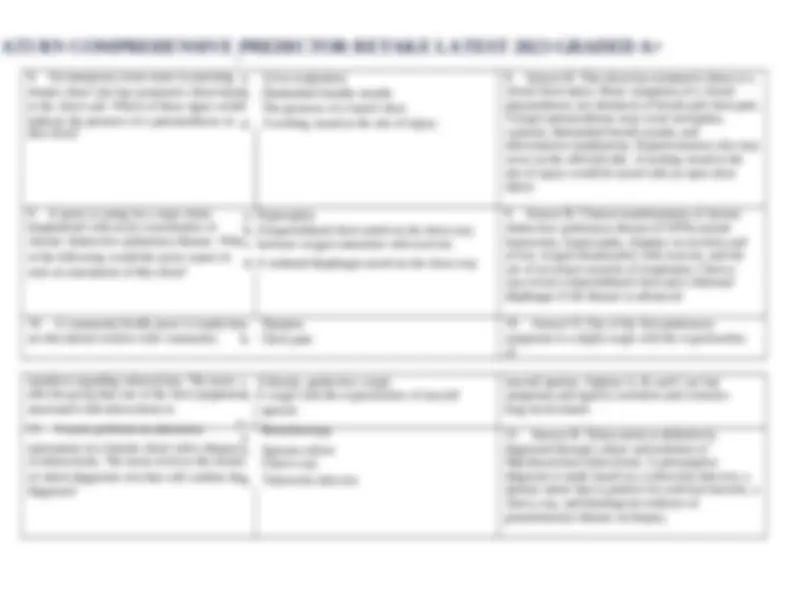
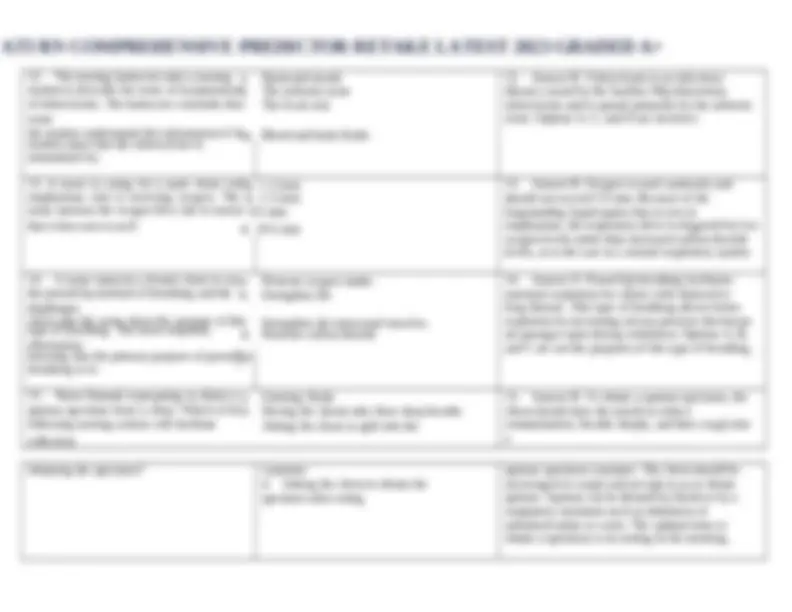
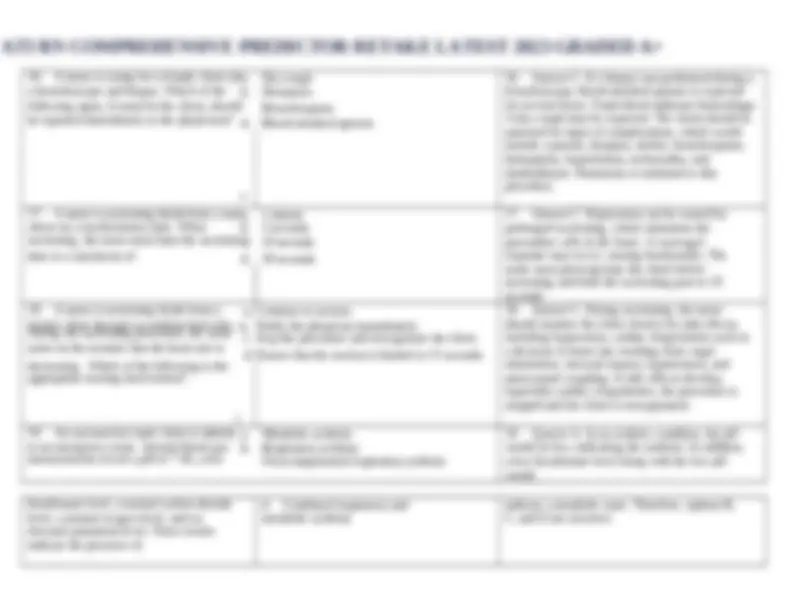
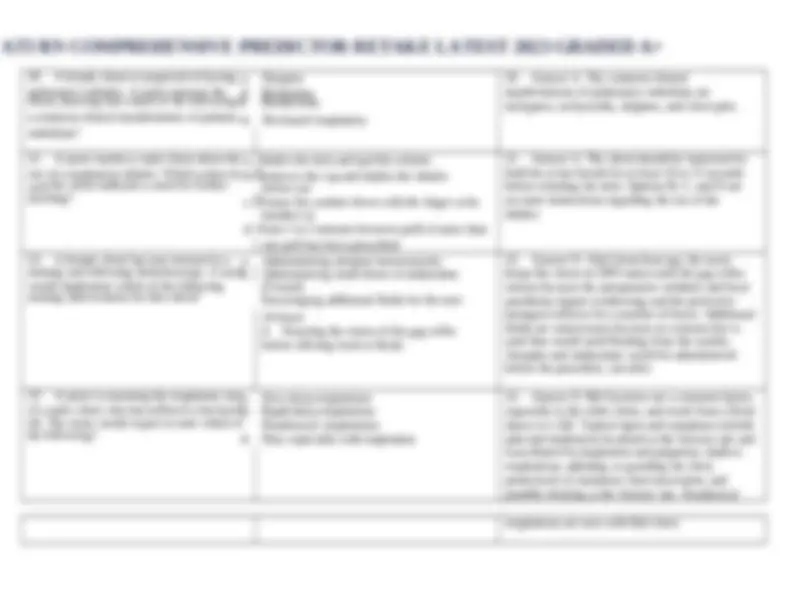
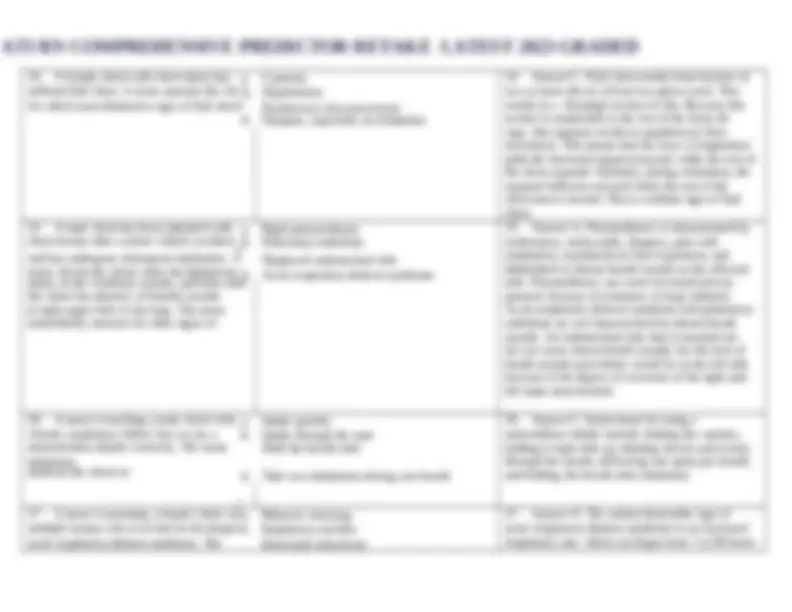
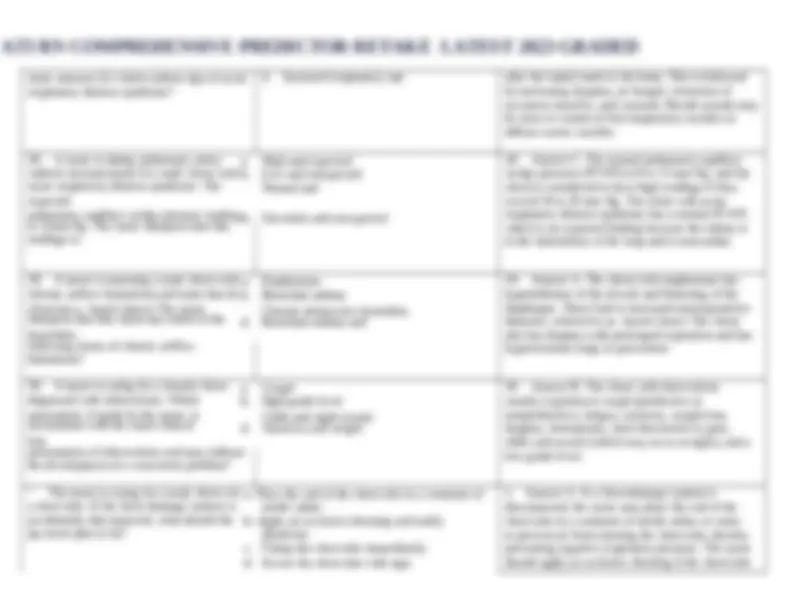
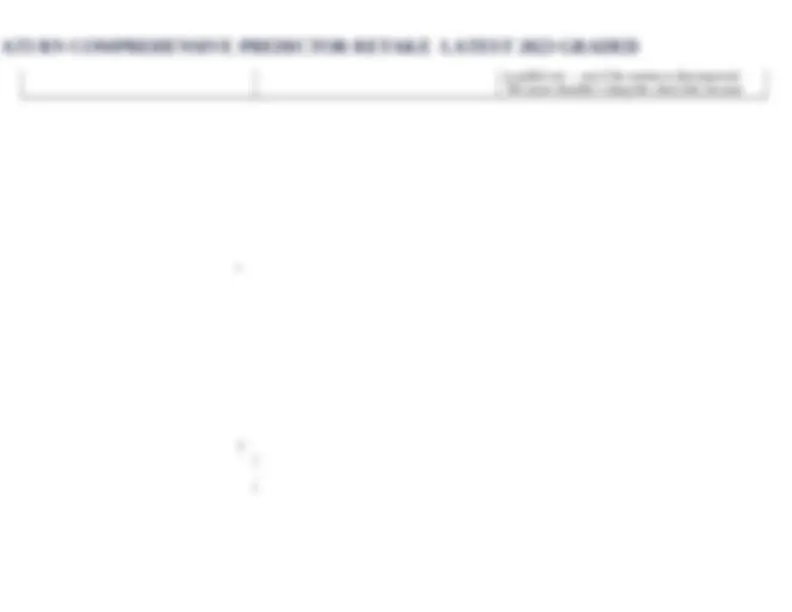
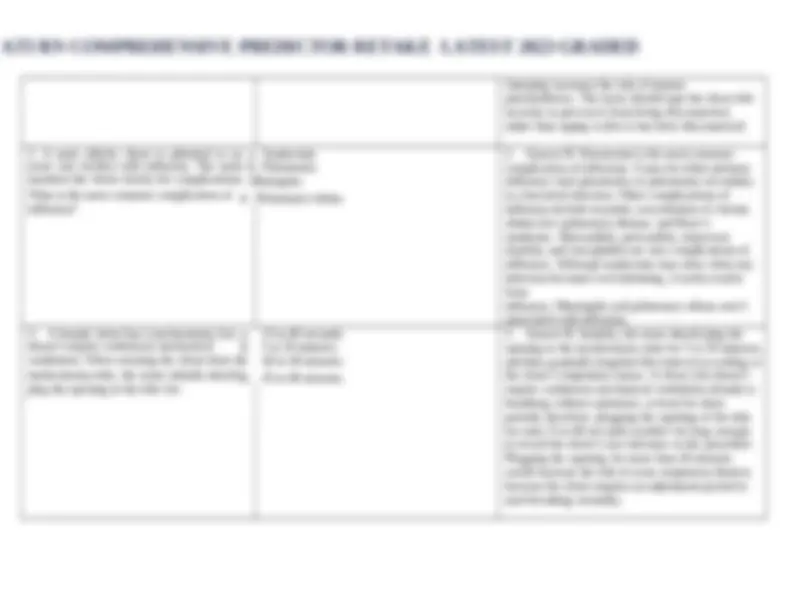
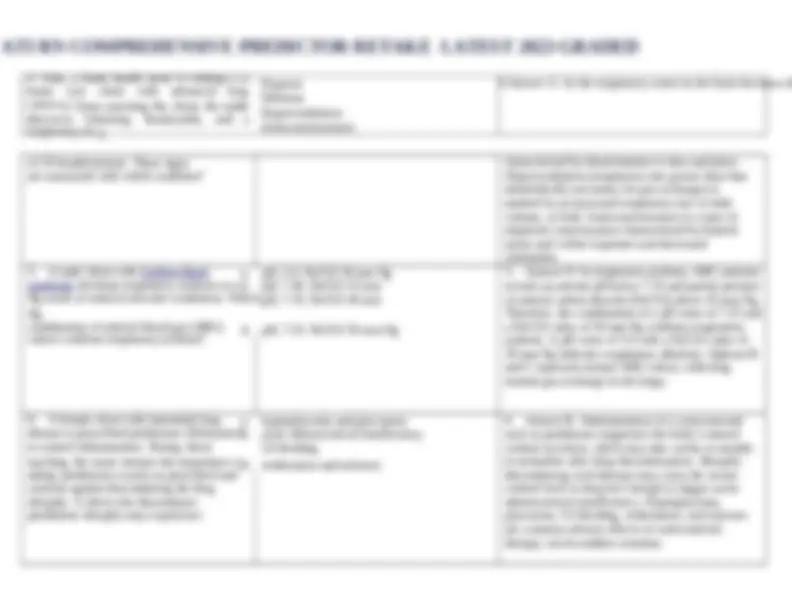
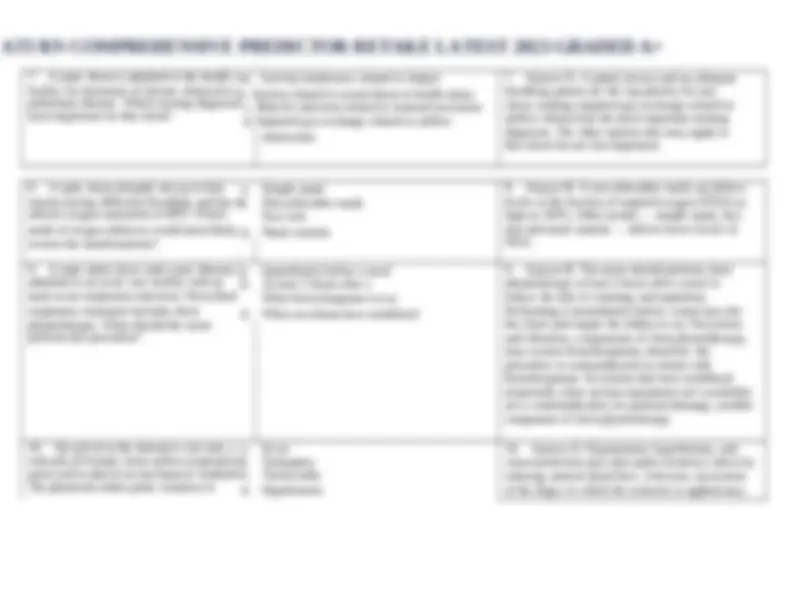
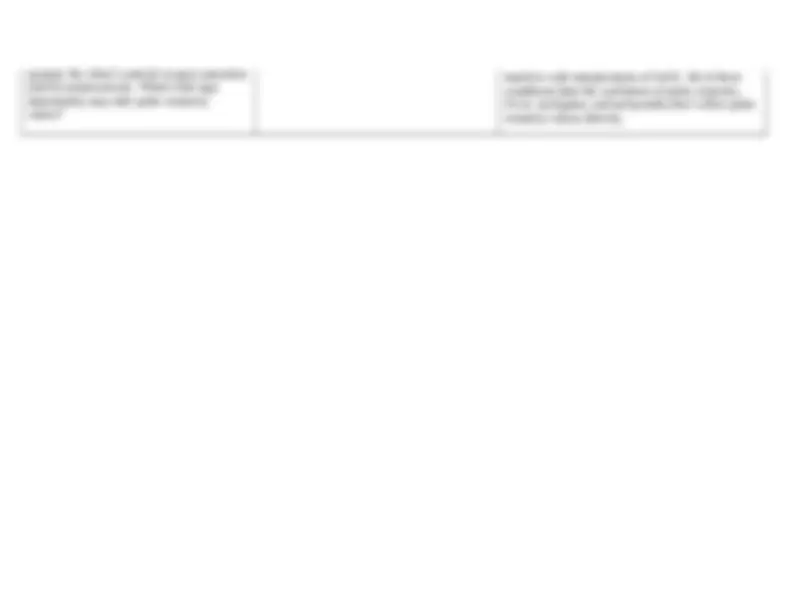
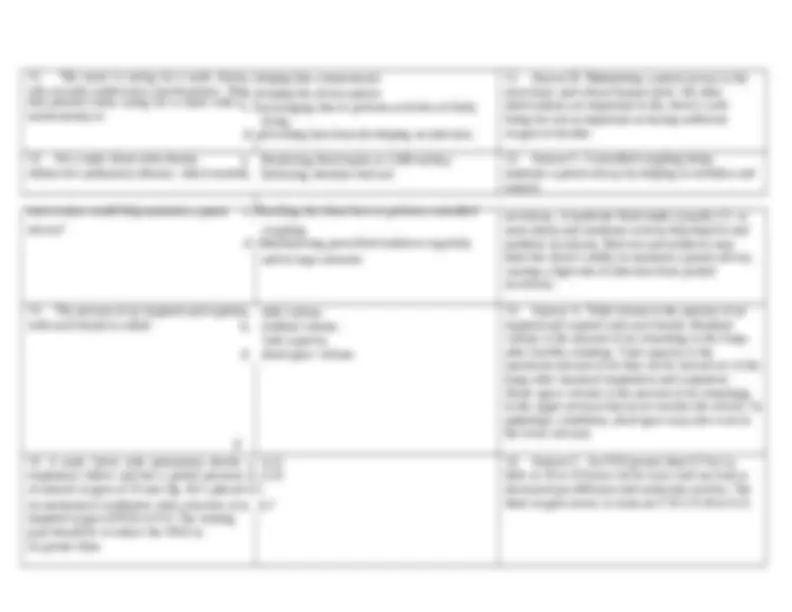
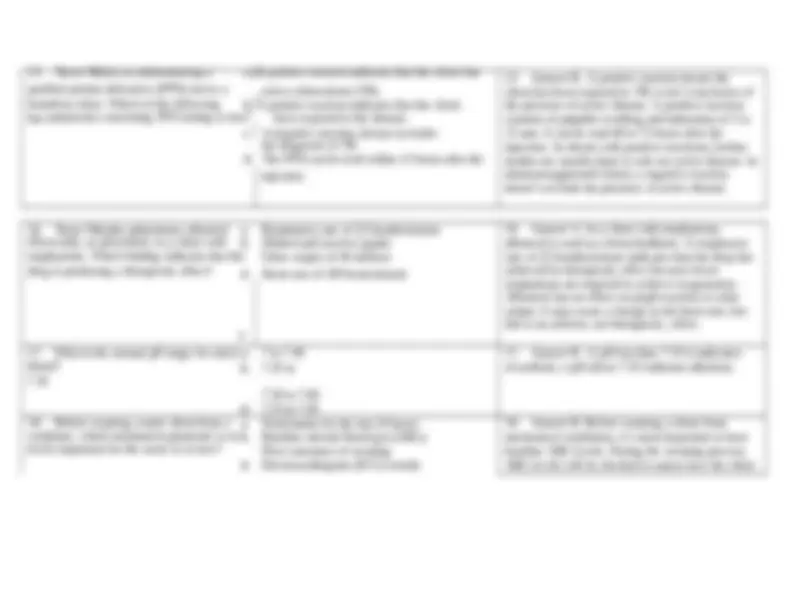
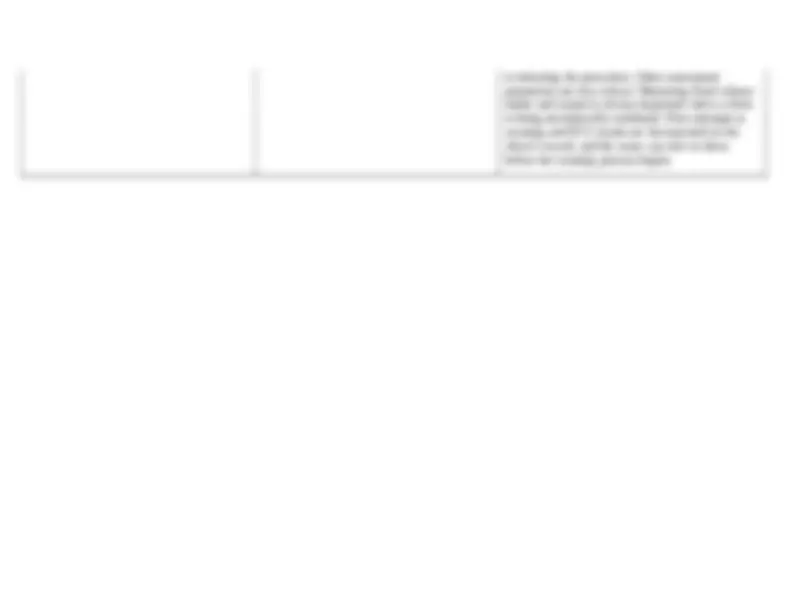
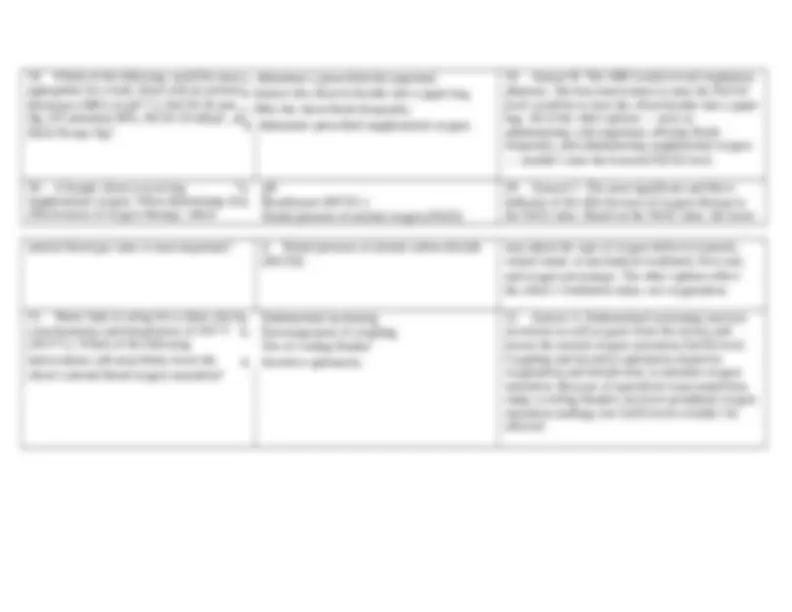
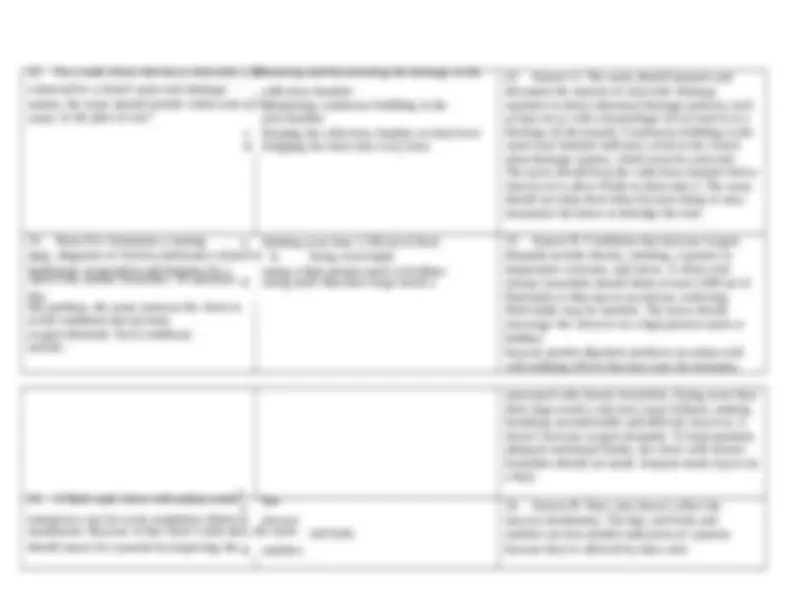
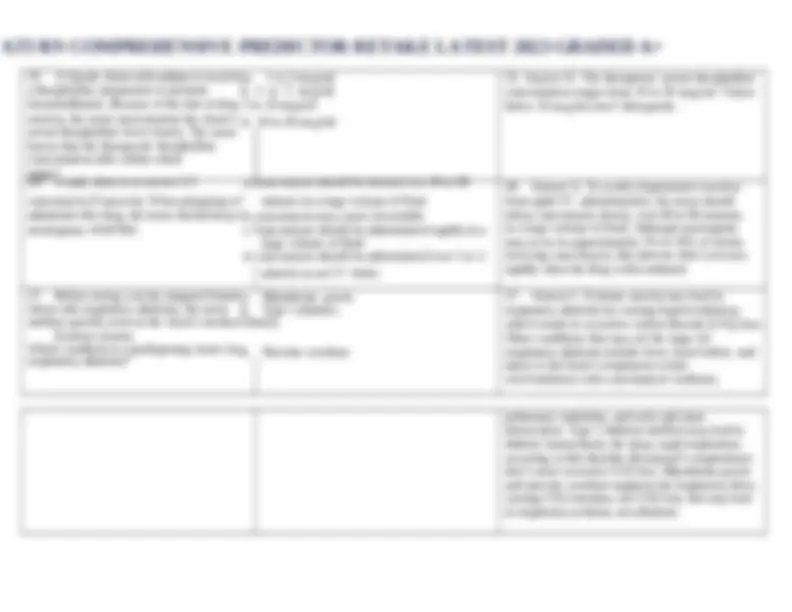
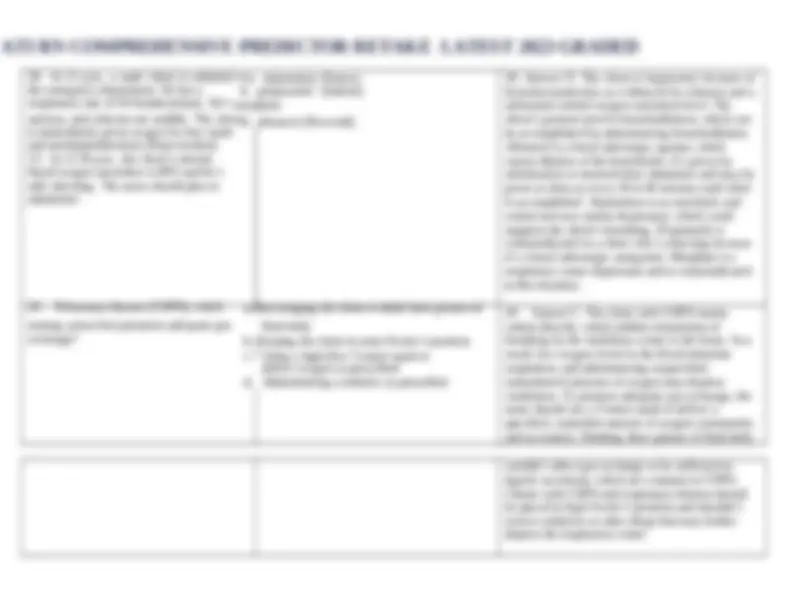
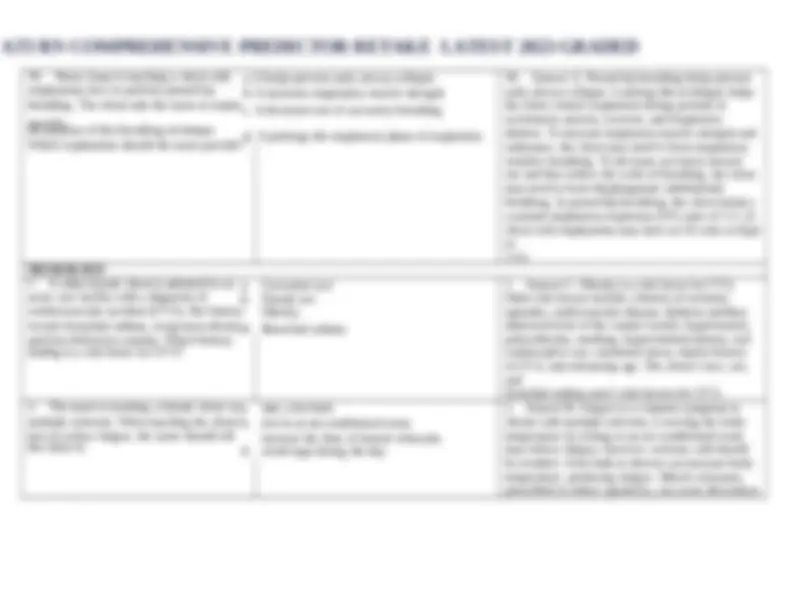


Study with the several resources on Docsity

Earn points by helping other students or get them with a premium plan


Prepare for your exams
Study with the several resources on Docsity

Earn points to download
Earn points by helping other students or get them with a premium plan
Community
Ask the community for help and clear up your study doubts
Discover the best universities in your country according to Docsity users
Free resources
Download our free guides on studying techniques, anxiety management strategies, and thesis advice from Docsity tutors
Answers to various nursing assessment questions related to different health conditions, including diabetes mellitus, cushing's syndrome, myasthenia gravis, bacterial meningitis, and more. It also offers advice on care plans, such as exercise frequency for diabetic clients, and precautions to prevent the spread of infections in a hospital setting.
Typology: Exams
1 / 179

This page cannot be seen from the preview
Don't miss anything!





























































































h
Nurse Ronn is assessing a client with a. Hypotension.
possible Cushing’s syndrome. In a client wit
b. Thick, coarse skin.
Cushing’s syndrome, the nurse would expect
c. Deposits of adipose tissue in the trunk and
adipose tissue accumulates in the trunk, face
(moonface), and dorsocervical areas (buffalo
hump).
to find:
dorsocervical area.
d. Weight gain in arms and legs.
Hypertension is caused by fluid retention. Skin
becomes thin and bruises easily because of a loss of
collagen. Muscle wasting causes muscle atrophy and
thin extremities.
A male client with primary diabetes a.
insipidus is ready for discharge on
desmopressin (DDAVP). Which instruction
should nurse Lina provide?
b.
Nurse Wayne is aware that a positive a.
Chvostek’s sign indicate? a. b.
Hypocalcemia
b. Hyponatremia d.
Hypokalemia
d. Hypermagnesemia
―Administer desmopressin while the suspension
is cold.‖
―Your condition isn’t chronic, so you won’t
need to wear a medical identification bracelet.‖
c.
―You may not be able to use desmopressin
nasally if you have nasal discharge or
blockage.‖
d. ―You won’t need to monitor your
fluid intake and output after you start
taking desmopressin.‖
Hypocalcemia
Hyponatremia
Hypokalemia
Hypermagnesemia
if the intranasal route is compromised. Although
diabetes insipidus is treatable, the client should wear
medical identification and carry medication at all
times to alert medical personnel in an emergency
and ensure proper treatment. The client must
continue to monitor fluid intake and output and
receive adequate fluid replacement.
the client’s face lightly over the facial nerve, just
below the temple. If the client’s facial muscles
twitch, it indicates hypocalcemia. Hyponatremia is
indicated by weight loss, abdominal cramping,
muscle weakness, headache, and postural
hypotension. Hypokalemia causes paralytic ileus and
muscle weakness. Clients with hypermagnesemia
exhibit a loss of deep tendon reflexes, coma, or
cardiac arrest.
n a. b. d. mineralization increases. Amenorrhea develops in Cushing’s syndrome. With successful treatment, the client experiences a return of menstrual flow, not a decline in it.
a. It decreases cyclic adenosine monophosphate surgical removal of a pituitary tumor. Dr. (cAMP) production and affects the metabolic Wong prescribes corticotropin (Acthar), 20 rate of target organs. units I.M. q.i.d. as a replacement therapy. b. It interacts with plasma membrane receptors to What is the mechanism of action of inhibit enzymatic actions. corticotropin? c. It interacts with plasma membrane receptors to produce enzymatic actions that affect protein, fat, and carbohydrate metabolism. d. It regulates the threshold for water resorption in
membrane receptors to produce enzymatic actions that affect protein, fat, and carbohydrate metabolism. It doesn’t decrease cAMP production. The posterior pituitary hormone, antidiuretic hormone, regulates the threshold for water resorption in the kidneys. the kidneys.
performed every 4 hours for a female client b. Onset to be at 2:15 p.m. and its peak to be at 3 diagnosed with diabetic ketoacidosis. Insulin p.m. is administered using a scale of regular insuli c. Onset to be at 2:30 p.m. and its peak to be at 4 according to glucose results. At 2 p.m., the p.m. client has a capillary glucose level of 250 d. Onset to be at 4 p.m. and its peak to be at 6 p.m.
shortacting insulin, has an onset of 15 to 30 minutes and a peak of 2 to 4 hours. Because the nurse gave the insulin at 2 p.m., the expected onset would be from 2:15 p.m. to 2:30 p.m. and the peak from 4 p.m. to 6 p.m. mg/dl for which he receives 8 U of regular insulin. Nurse Vince should expect the dose’s:
a. Serum glucose level. being successfully treated for Cushing’s b. Hair loss. syndrome, nurse Lyzette would expect a Bone mineralization. decline in: d. Menstrual flow.
from glucocorticoid excess, is a manifestation of Cushing’s syndrome. With successful treatment of the disorder, serum glucose levels decline. Hirsutism is common in Cushing’s syndrome; therefore, with successful treatment, abnormal hair growth also declines. Osteoporosis occurs in Cushing’s syndrome; therefore, with successful treatment, bone Serum glucose level. Hair loss. Bone mineralization. Menstrual flow.
a
male client with the syndrome of b. Neck vein distention
inappropriate antidiuretic hormone (SIADH)
Weight loss
secretion is experiencing complications?
d. Polyuria
antidiuretic hormone overproduction, which leads to
fluid retention. Severe SIADH can cause such
complications as vascular fluid overload, signaled by
neck vein distention. This syndrome isn’t associated
with tetanic contractions. It may cause weight gain
and fluid retention (secondary to oliguria).
pheochromocytoma is admitted to the hospit b. methyldopa (Aldomet).
in an acute hypertensive crisis. To reverse
mannitol (Osmitrol).
hypertensive crisis caused by
d. felodipine (Plendil).
excessive production of epinephrine and
norepinephrine, natural catecholamines that raise the
blood pressure. Phentolamine, an alpha-adrenergic
blocking agent given by I.V. bolus or drip,
antagonizes the body’s response to circulating
epinephrine and norepinephrine, reducing blood
pressure quickly and effectively. Although
methyldopa is an antihypertensive agent available in
parenteral form, it isn’t effective in treating
hypertensive emergencies. Mannitol, a diuretic, isn’t
used to treat hypertensive emergencies. Felodipine,
pheochromocytoma, nurse Lyka expects to
administer:
an antihypertensive agent, is available only in
extended-release tablets and therefore doesn’t
reduce blood pressure quickly enough to correct
hypertensive crisis.
hypertension is diagnosed with primary b. Pancreas
hyperaldosteronism. This diagnosis indicates Adrenal medulla
that the client’s hypertension is caused by
d. Parathyroid
in the adrenal cortex is responsible for the client’s
hypertension. This hormone acts on the renal
tubule, where it promotes reabsorption of sodium
and excretion of potassium and hydrogen ions. The
pancreas mainly secretes hormones involved in fuel
metabolism. The adrenal medulla secretes the
catecholamines — epinephrine and norepinephrine.
The parathyroids secrete parathyroid hormone.
excessive hormone secretion from which of
the following glands?
e
s
g
appropriate for a client with Addison’s b. Excessive fluid volume
disease?
Urinary retention
d. Hypothermia
production of all adrenal hormones, compromising
the body’s normal stress response and increasing
the risk of infection. Other appropriate nursing
diagnoses for a client with Addison’s disease include
Deficient fluid volume and Hyperthermia. Urinary
retention isn’t appropriate because Addison’s disease
causes polyuria.
absorption, so the client should take an oral form of
dextrose rather than a product containing table sugar
when treating hypoglycemia. The alpha-glucosidase
inhibitors work by delaying the carbohydrate
digestion and glucose absorption. It’s safe to be on a
regimen that includes insulin and an
alphaglucosidase inhibitor. The client should take
the drug at the start of a meal, not 30 minutes to an
hour
before.
inhibitor, is prescribed for a female client with
sugar, not dextrose.‖
type 2 diabetes mellitus. During discharge
b.
―The drug makes my pancreas release
more
planning, nurse Pauleen would be aware of the
insulin.‖
client’s need for additional teaching when the
client states:
c. ―I should never take insulin while I’m taking
this drug.‖
d. ―It’s best if I take the drug with the first bite of a
meal.‖
surgery.‖ suggest a hyperpituitary condition undergoes
b. ―You must avoid coughing,
sneezing, and
an extensive diagnostic workup. Test results
blowing your nose.‖
reveal a pituitary tumor, which necessitates a
transphenoidal hypophysectomy. The evenin
c. ―You must restrict your fluid intake.‖
hypophysectomy, the client must refrain from
coughing, sneezing, and blowing the nose for
several
days to avoid disturbing the surgical graft used to
close the wound. The head of the bed must be
before the surgery, nurse Jacob reviews
preoperative and postoperative instructions
given to the client earlier. Which
postoperative instruction should the nurse
emphasize?
d. ―You must report ringing in your
ears immediately.‖
elevated, not kept flat, to prevent tension or pressure
on the suture line. Within 24 hours after a
hypophysectomy, transient diabetes insipidus
commonly occurs; this calls for increased, not
restricted, fluid intake. Visual, not auditory, changes
are a potential complication of hypophysectomy.
s
h
or
gain and edema
d. Imbalanced nutrition: Less than body
requirements related to thyroid hormone
excess
and depletion. This puts the client at risk for
marked nutrient and calorie deficiency, making
Imbalanced nutrition: Less than body requirements
the most important nursing diagnosis. Options B
and C may be appropriate for a client with
hypothyroidism,
which slows the metabolic rate.
of hyperosmolar hyperglycemic nonketotic b. Serum sodium level
syndrome (HHNS) has a history of type 2
Arterial blood gas (ABG)
values
diabetes that is being controlled with an oral
d.
Serum osmolarity
important test for confirming HHNS; it’s also used
to guide treatment strategies and determine
evaluation criteria. A client with HHNS typically has
a serum osmolarity of more than 350 mOsm/L.
Serum potassium, serum sodium, and ABG values
are also measured, but they aren’t as important as
serum osmolarity for confirming a diagnosis of
HHNS. A client with HHNS typically has
hypernatremia and osmotic diuresis. ABG values
reveal acidosis, and the potassium level is variable.
diabetic agent, tolazamide (Tolinase). Which
of the following is the most important
laboratory test for confirming this
disorder?
You’ll need more insulin when you exercise or
hypothyroidism, and certain medications decrease
the insulin requirements. Growth, pregnancy, greater
food intake, stress, surgery, infection, illness,
increased insulin antibodies, and certain medications
increase the insulin requirements.
with type 1 diabetes mellitus. When teaching
increase your food intake.‖
the client and family how diet and exercise
b. ―You’ll need less insulin when you exercise
or affect insulin requirements, Nurse Joy should
reduce your food intake.‖
include which guideline?
c. ―You’ll need less insulin when you increase
your food intake.‖
d. ―You’ll need more insulin when you exercise or
decrease your food intake.‖
her diabetic client, then monitors the client f b. Anabolic steroids
adverse drug reactions and interactions. Whic
Beta-adrenergic blockers
type of drug interacts adversely with
d. Thiazide diuretics
glucagon only interacts adversely with oral
anticoagulants,
increasing the anticoagulant effects. It doesn’t
interact adversely with anabolic steroids,
betaadrenergic blockers, or thiazide diuretics.
glucagon?
t
administration should nurse Kate give to
a client?
a. ―Always follow the same order when
drawing the different insulins into the syringe.‖
b. ―Shake the vials before withdrawing
the insulin.‖
c. ―Store unopened vials of insulin in the
always to follow the same order when drawing the
different insulins into the syringe. Insulin should
never be shaken because the resulting froth prevents
withdrawal of an accurate dose and may damage
the
freezer at temperatures well below freezing.‖
d. ―Discard the intermediate-acting insulin if
it appears cloudy.‖
insulin protein molecules. Insulin also should never
be frozen because the insulin protein molecules may
be damaged. Intermediate-acting insulin is normally
cloudy.
with type 1 diabetes mellitus who exhibits
b. I.V. bolus of dextrose 50%.
confusion, light-headedness, and aberrant
c. 15 to 20 g of a fast-acting carbohydrate such
as behavior. The client is still conscious. The
orange juice.
nurse should first administer:
d.
10 U of fast-acting insulin.
hypoglycemic episode. Because the client is
conscious, the nurse should first administer a
fastacting carbohydrate, such as orange juice, hard
candy, or honey. If the client has lost
consciousness, the nurse should administer either
I.M. or subcutaneous glucagon or an I.V. bolus of
dextrose 50%. The nurse shouldn’t administer
insulin to a client who’s hypoglycemic; this action
will further compromise the client’s condition.
thyroidectomy surgery, nurse Jamie would b. Hypercalcemia
assess the female client for Chvostek’s sign
Hypokalemia
and Trousseau’s sign because they indicate
d.
Hyperkalemia
thyroidectomy is at risk for developing
hypocalcemia from inadvertent removal or damage
to the parathyroid gland. The client with
hypocalcemia will exhibit a positive Chvostek’s
sign (facial muscle contraction when the facial
nerve in front of the ear is tapped) and a positive
Trousseau’s sign (carpal spasm when a blood
pressure cuff is
inflated for a few minutes). These signs aren’t
present with hypercalcemia, hypokalemia, or
hyperkalemia.
which of the following?
or
h
h
clients, a female client asks the nurse educat b. At least three times a
week how often to exercise. The nurse educator
At least five times a week
advises the clients to exercise how often to
d. Every day
least three times a week to meet the goals of planned
exercise — lowering the blood glucose level,
reducing or maintaining the proper weight,
increasing the serum high-density lipoprotein level,
decreasing serum triglyceride levels, reducing blood
pressure, and minimizing stress. Exercising once a
week wouldn’t achieve these goals. Exercising more
than three times a week, although beneficial, would
exceed the minimum requirement.
meet the goals of planned exercise?
loss
hypothyroidism to report which health b. Puffiness of the face and hands
concerns?
Nervousness and tremors
d. Thyroid gland swelling
facial puffiness, extremity edema, and weight gain.
Signs and symptoms of hyperthyroidism (Graves’
disease) include an increased appetite, weight loss,
nervousness, tremors, and thyroid gland enlargement
(goiter).
(myxedema) is receiving levothyroxine b. Leg cramps
(Synthroid), 25 mcg P.O. daily. Which finding Tachycardia
should nurse Hans recognize as an adverse
d. Blurred vision
hormone, is given to a client with hypothyroidism
to simulate the effects of thyroxine. Adverse effects
of this agent include tachycardia. The other options
aren’t associated with levothyroxine. drug effect?
complaining of sleeping more, increased b. Diabetes insipidus
urination, anorexia, weakness, irritability, Hypoparathyroidism
depression, and bone pain that interferes wit
d. Hyperparathyroidism
common in older women and is characterized by
bone pain and weakness from excess parathyroid
hormone (PTH). Clients also exhibit
hypercaliuriacausing polyuria. While clients with
diabetes mellitus and diabetes insipidus also have
polyuria, they don’t have bone pain and
increased
sleeping. Hypoparathyroidism is characterized by
urinary frequency rather than polyuria.
her going outdoors. Based on these
assessment findings, nurse Richard
would suspect which of the following
disorders?
e
Synthetic). diabetes insipidus, nurse Juliet expects to b. furosemide
(Lasix).
administer:
regular insulin.
d. 10% dextrose.
from decreased antidiuretic hormone (vasopressin)
production, the nurse should expect to administer
synthetic vasopressin for hormone replacement
therapy. Furosemide, a diuretic, is contraindicated
because a client with diabetes insipidus experiences
polyuria. Insulin and dextrose are used to treat
diabetes mellitus and its complications, not
diabetes
insipidus.
the most common cause of b. A pituitary adenoma
hyperaldosteronism?
Deficient potassium
intake
d. An adrenal adenoma
aldosteroneproducing adenoma is the most common
cause of hyperaldosteronism. Hyperplasia is the
second most frequent cause. Aldosterone secretion is
independent of sodium and potassium intake as well
as of pituitary stimulation.
an objective measure of glycemic control over a
3month period. The test helps identify trends or
practices that impair glycemic control, and it
doesn’t require a fasting period before blood is
drawn. The
mellitus has a highly elevated glycosylated
12-hour fast.‖
hemoglobin (Hb) test result. In discussing th
b. ―It looks like you aren’t following
the
result with the client, nurse Sharmaine would
prescribed diabetic diet.‖
be most accurate in stating:
c. ―It tells us about your sugar control for the
last 3 months.‖
d. ―Your insulin regimen needs to be
altered significantly.‖
nurse can’t conclude that the result occurs from poor
dietary management or inadequate insulin coverage.
nurse Betty would assess for hyperkalemia b. Tremors
shown by which of the following?
Diaphoresis
d. Constipation
nausea, diarrhea, and paresthesia of the hands, feet,
tongue, and face are findings associated with
hyperkalemia, which is transient and occurs from
transient hypoaldosteronism when the adenoma is
removed. Tremors, diaphoresis, and constipation
aren’t seen in hyperkalemia.
ordered
the syndrome of inappropriate antidiuretic b. Encouraging increased oral
intake hormone (SIADH). Which nursing
c. Restricting fluids
intervention is appropriate?
d. Administering glucose-containing I.V. fluids as
client with the SIADH, the nurse should restrict
fluids. Administering fluids by any route would
further increase the client’s already heightened fluid
load.
ordered
t
s
d
level of 7.2 mg/dl. During the physical b. Homans’ sign.
examination, nurse Noah expects to assess:
Hegar’s sign.
d. Goodell’s sign.
indicates hypocalcemia, an electrolyte imbalance
that causes Trousseau’s sign (carpopedal spasm
induced by inflating the blood pressure cuff above
systolic pressure). Homans’ sign (pain on
dorsiflexion of the foot) indicates deep vein
thrombosis. Hegar’s sign (softening of the uterine
isthmus) and Goodell’s sign (cervical softening)
are probable signs of pregnancy.
of a male client with diabetes insipidus has
b. Urine output measures more than 200 ml/hour.
been effective?
c. Blood pressure is 90/50 mm Hg.
d. The heart rate is 126 beats/minute.
by polyuria (up to 8 L/day), constant thirst, and an
unusually high oral intake of fluids. Treatment with
the appropriate drug should decrease both oral fluid
intake and urine output. A urine output of 200
ml/hour indicates continuing polyuria. A blood
pressure of 90/50 mm Hg and a heart rate of 126
beats/minute indicate compensation for the
continued fluid deficit, suggesting that treatment
hasn’t been effective.
has been diagnosed with hyperglycemia tell b. Type 1 diabetes
mellitus the nurse that her husband sleeps in another
Hypothyroidism
room because her snoring keeps him awake.
d. Deficient growth hormone
pituitary tumor that releases excessive growth
hormone, is associated with hyperglycemia,
hypertension, diaphoresis, peripheral neuropathy,
and joint pain. Enlarged hands and feet are related to
lateral bone growth, which is seen in adults with this
disorder. The accompanying soft tissue swelling
causes hoarseness and often sleep apnea. Type 1
The nurse notices that she has large hands and
a hoarse voice. Which of the following would
the nurse suspect as a possible cause of the
client’s hyperglycemia?
diabetes is usually seen in children, and newly
diagnosed persons are usually very ill and thin.
Hypothyroidism isn’t associated with
hyperglycemia, nor is growth hormone deficiency.
months, a male client experiences secondary
b. Switch the client to a different oral
antidiabetic failure. Which of the following would the
agent.
nurse expect the physician to do?
c. Prescribe an additional oral antidiabetic agent.
d. Restrict carbohydrate intake to less than 30% of
secondary failure respond to a different oral
antidiabetic agent. Therefore, it wouldn’t be
appropriate to initiate insulin therapy at this time.
However, if a new oral antidiabetic agent is
unsuccessful in keeping glucose levels at an
acceptable level, insulin may be used in addition
to
the antidiabetic agent.
the total caloric intake.
female client who will undergo subtotal
a. ―The head of your bed must remain flat for
24 hours after surgery.‖
surgical incision after subtotal thyroidectomy, the
nurse should advise the client to avoid
hyperextending the neck. The client may elevate
the head of the bed as desired and should perform
deep breathing and coughing to help prevent
pneumonia.
Subtotal thyroidectomy doesn’t affect swallowing.
thyroidectomy, the nurse should include whi
b. ―You should avoid deep breathing and coughing
statement?
after surgery.‖
c. ―You won’t be able to swallow for the first
day or two.‖
d. ―You must avoid hyperextending your neck after
surgery.‖
client who has a diagnosis of chronic
b. 100 units/L
pancreatitis. The nurse reviews the laboratory 300 units/L
result, anticipating a laboratory report that
d. 500 units/L
25 to 151 units/L. With chronic cases of
pancreatitis
indicates a serum amylase level of:
surgery has been advanced from a clear liq b. Gelatin
diet to a full liquid diet. The client is looking Custard
forward to the diet change because he has
d. Popsicle
items such as plain ice cream
been ―bored‖ with the clear liquid diet. The
nurse would offer which full liquid item to the
client?
cirrhosis of the liver. To minimize the effect b. Milk
of the disorder, the nurse teaches the client Chicken
about foods that are high in thiamine. The
d. Broccoli
consume foods high in thiamine. Thiamine is
present in a variety of foods of plant and animal
origin. Pork products are especially rich in this
vitamin. Other
h
ld
id
s
c
nurse determines that the client has the best
good food sources include nuts
o
u
t
s.
he
tube connected to suction
medication through a nasogastric tube that is medication absorption
connected to suction. To administer the
b. Aspirate the nasogastric tube after medication
medication, the nurse would:
administration to maintain patency c. Clamp
the nasogastric tube for 30 minutes following
administration of the medication d. Change
the suction setting to low intermittent suction
for 30 minutes after
medication administration
client with esophageal varices who has just b. Kelly clamp
has a Sengstaken-Blakemore tube inserted. An irrigation set
The nurse gathers supplies, knowing that
d. A pair of scissors
Sengstaken- Blakemore tube
which of the following items must be kept at
the bedside at all times?
with hepatitis has contracted the infection b. Hepatitis B
form contaminated food. The nurse
Hepatitis C
understands that this client is most likely
d. Hepatitis D
fecal-oral route via contaminated food or
infected food handlers. Hepatitis B
experiencing what type of hepatitis?
Which diagnostic test result will assist in b. Elevated serum bilirubin
level
confirming this diagnosis?
Elevated blood urea nitrogen level
d. Decreased erythrocycle sedimentation rate
hepatitis include elevated liver enzyme levels
orders written for a male client admitted to t b. Nasogastric tube inserted
hospital with acute pancreatitis. Which Morphine sulfate for pain
physician order should the nurse question if
d.
An anticholinergic
medication
morphine sulfate is the medication of choice to
treat pain because morphine sulfate can cause
spasms in the sphincter of Oddi. Options A
noted on the client’s chart?
r
ith
e
t
physician’s office has just been scheduled fo
b. Eat a regular supper and
breakfast
a barium swallow the next day. The nurse
c. Continue to take all oral medications
as writes down which instruction for the client to
scheduled
follow before the test?
d. Monitor own bowel movement pattern for
study that uses a substance called barium for
contrast to highlight abnormalities in the
gastrointestinal tract. The client should fast for 8 to
12 hours before the test
constipation
assessment and inspects the skin of the
b. Palpates the liver at the right rib
margin
abdomen. The nurse performs which
c. Listens to bowel sounds in all for quadrants
assessment technique next?
d. Percusses the right lower abdominal quadrant
for abdominal examination is inspection
(GoLYTELY) is prescribed for the female b. Administer an enema
client scheduled for a colonoscopy. The client
Cancel the diagnostic
test
bowel evacuant used to prepare a client for a
colonoscopy by cleansing the bowel. The solution is
begins to experience diarrhea following
administration of the solution. What action by
the nurse is appropriate?
d. Explain that diarrhea is expected expected to cause a mild diarrhea and will clear
the bowel in 4 to 5 hours. Options A
a diagnosis of chronic gastritis. The nurse b. Vitamin B
monitors the client knowing that this client is Vitamin C
at risk for which vitamin deficiency?
d.
Vitamin E
deterioration and atrophy of the lining of
the stomach
record of a female client with acute gastritis. b. Furosemide (Lasix)
Which medication, if noted on the client’s Indomethacin (Indocin)
record, would the nurse question?
d. Propranolol hydrochloride (Inderal)
nonsteroidal anti-inflammatory drug and can
cause ulceration of the esophagus
s
Clamp the T tube
a.
hours following a cholecystectomy. The nur
b. Irrigate the T tube
noted that the T tube has drained 750 mL of
Notify the
physician
green-brown drainage since the surgery.
d. Document the findings
Which nursing intervention is appropriate?